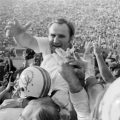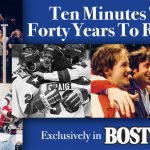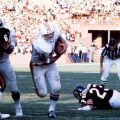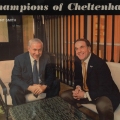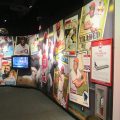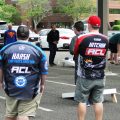PhillyMan

Eagles Tailgating: The Greatest Party in Greater Philadelphia
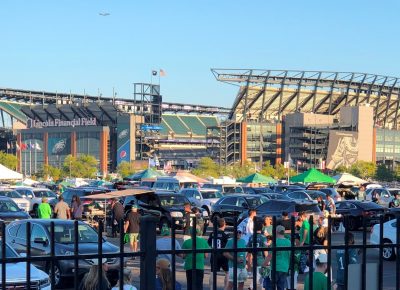
There is no gathering anywhere in the region like an Eagles tailgate. (Published for the Fall 2023 issue of PhillyMan…see the magazine article here.)

Most of the thousands clad in green at the party on Pattison probably don’t even realize it, but there is a truly special element to being in the parking lot on Eagles game day.
It’s that no matter your political persuasion, your religious denomination, your ancestral roots or your musical taste, you have something in common with the stranger next to you. In the parking lots surrounding Lincoln Financial Field on game day, everyone bleeds green and shows their commitment. On Game Day, the Birds are the only thing that matters to anyone.
Tailgating, at first glance, seems an alternative to paying the eternally brazen “atmosphere fee” for food and libations inside a sports venue. But when the party encompasses more than a square mile and looks like this, its purpose goes well beyond thrift. To call an Eagles tailgate a party, to even call it a celebration, is a rank understatement.
Throughout the lots at the home of the Eagles, including those meant for other teams who happen to play here, you can walk in any direction and see buses, campers, trucks and vans…the majority of them covered with artwork that would provoke a double take on the highway. It gives one pause to consider how much of a fan one must be to shell out the kind of coin needed to decorate a vehicle so magnificently.

After a long day of painting a bus, it’s time for a drink.
Everywhere in this mammoth block party, one hears loud music from a variety of styles and eras. Everywhere, you can smell coal, sausages, burgers, and yes, frequent whiffs of reefer. And anywhere you happen to be, you won’t often go five minutes without hearing an Eagles cheer…usually begun by one person, which easily gets at least a dozen more to join in.
If you’ve never been a part of tailgating at this level, you’ll be truly amazed at the dedication of a large number of participants. The seasoned pros arrive early…as much as six to eight hours before game time. (Do the math of how early you’d have to get out of bed, on a cold November Sunday morning, to tailgate for a 1:00 game.)
Veterans of Eagles tailgating even have their designated parking spots, that they head directly to when the gates open…for various reasons, such as being near a grate that can be used as a bathroom. True.
You can easily spot the amateurs…the late arrivals. They spend far too much time in an agonizingly slow quest…not only to find an open spot, but to work their way into it as carefully as possible to avoid gazebos, coolers, and equipment that other tailgaters have established hours before.
Hopefully they’ve learned their lesson from the experience…you need to take this party a heretofore unheard of other level of seriously.
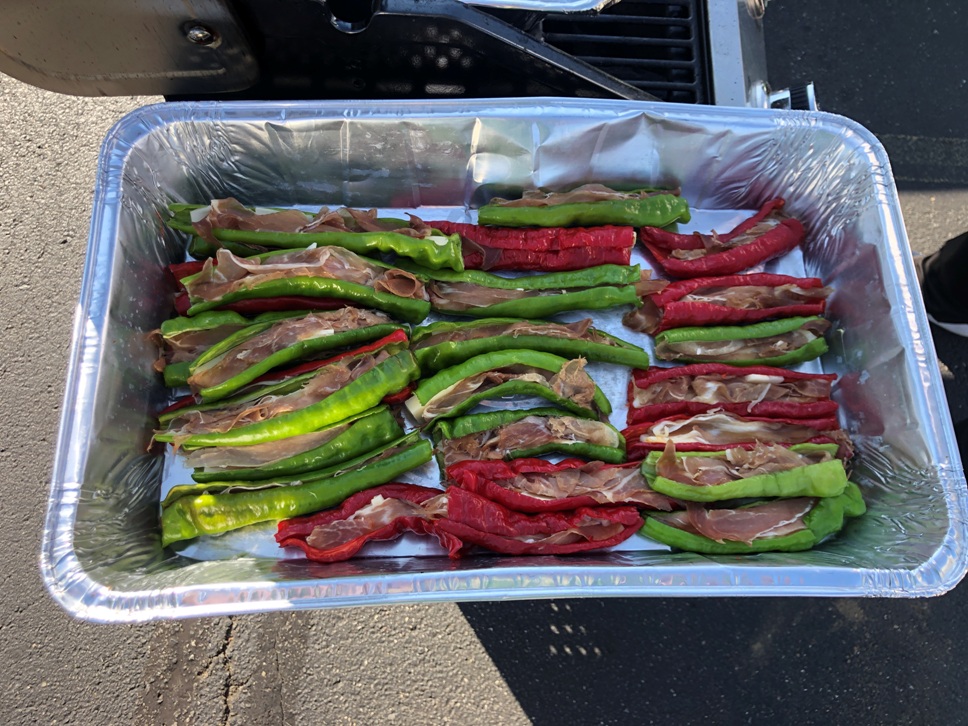
Dan Kukral’s stuffed long hots are reason enough to be part of the Danny Burke tailgate on game day.
Dan Kukral is the head chef of the Danny Burke tailgate, named for his brother-in-law who runs much of the party. He was given the chef’s role, he says, because “I come up with all the fun ideas for food.”
Kukral is a research scientist at a pharmaceutical company, which is remarkable given what you’re about to read about his contribution to game day.
He and Burke usually begin the party preparation about five to six days before game day (yes, you read that right). Once they’ve gathered food and supplies for a party that can be for as many as 200-300 people and brought it all to the Linc, he takes on the sizable cooking duties.
Needless to say, it’s a lot for one guy. Kukral simultaneously looks after the preparation of ribs, pulled pork, shrimp and sausage bayou, Buffalo chicken dip, and of course, dogs, burgers, wings, sausages with peppers and onions…even long hots with stuffed provolone and prosciutto. As anyone can easily see from the hefty, mouth-watering piles of grub, he’s more than up to the challenge.
It’s all a labor of love, he says. No kidding…a system as efficient as this doesn’t happen casually. The Danny Burke folks get contributions from participants, which covers the food and drink, but he doesn’t get paid for his more than considerable efforts.
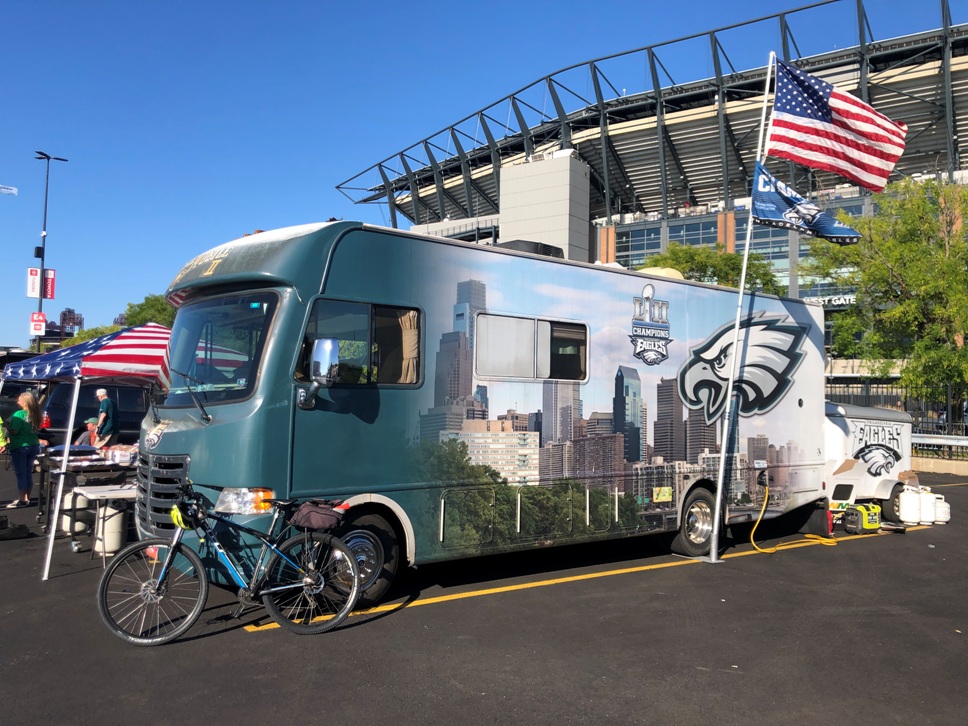
If you think this pain job is impressive, check out the back.
Kukral is just one of many for whom Eagles fandom is a passion worth the investment of time and money.
This observer also spoke with Ed Callahan, whose camper has occupied a spot in the Wells Fargo Center lot since the opening of Lincoln Financial Field. Ed tells an amusing story of why he and his crew acquired a camper.
“In 2004,” he recalls, “I went to a road trip game in Cleveland. There were four of us, and we parked in the lot next to a beat-up old RV. For a swap of a cheesesteak, the guy who owned the RV let us use the bathroom.”
An even trade, certainly. But bringing a bathroom to a tailgate, they realized, was a super idea, for obvious reasons.
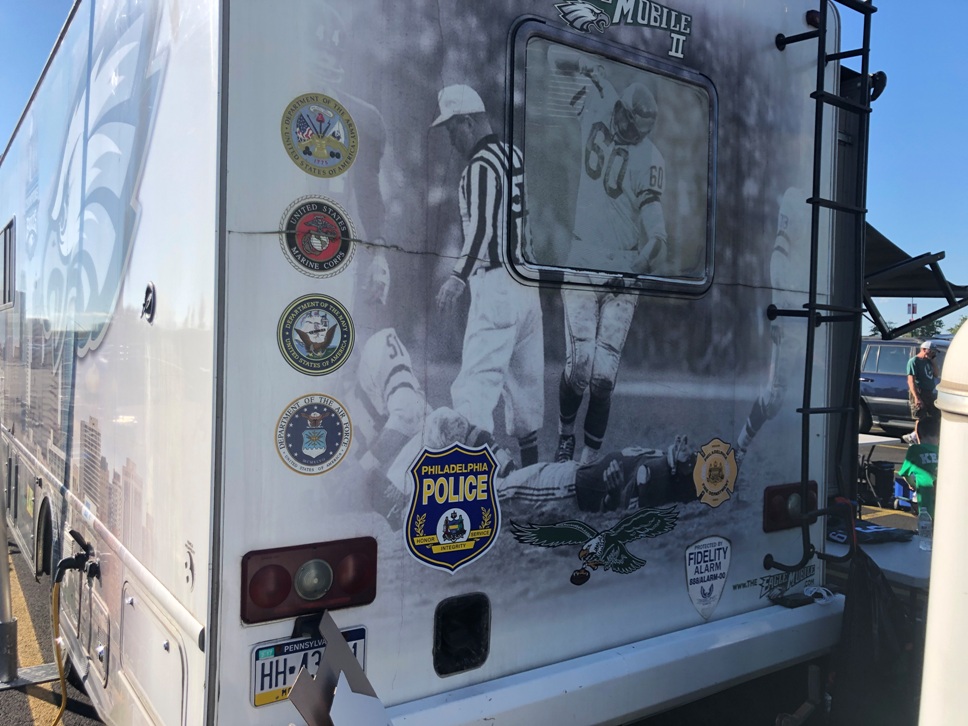
“I’ll knock the loyalty to Kathie Lee right out of you!!”
Ed and his crew bought an old RV, fixed it up, and made it a staple of the parking lot. They eventually had to replace it following a wreck, so they’ve upgraded to a new one.
Callahan’s current camper is a thing of beauty to behold for a Philadelphia football fan, and it might be the most artfully decorated vehicle at the Eagles tailgate…which is undeniably saying something. The back of the RV is adorned with a large scale timeless image of Frank Gifford lying motionless on the field, following the epic Chuck Bednarik hit. On the side is a wide panorama skyline shot of our city, ranging from 30th Street Station to Billy Penn’s statue.

Anthony is the right man for the job.
The cook of Callahan’s crew is a gentleman named Anthony. Anthony is definitely keeping busy looking after sausages and other comestibles. He estimates that their party serves anywhere from 30-100 fans each home game.
Executing a successful tailgate, Anthony says, is a full-time job. “All week, getting food together, cleaning the RV, getting all the grills, utensils, tables, and all that. It’s a full day…breakfast, lunch and dinner in the parking lot.”
Ed says their breakfast specialty is an Irish American Philly Omelet… made with imported Kerrygold cheese from Ireland, Cooper brand American cheese, and Philadelphia cream cheese, all in a three egg concoction.
There might be a few NFL cities that are in Philadelphia’s universe when it comes to the magnitude of the pre-game party. But there is one thing that The City of Brotherly Love offers that is unique: cheesesteaks, scrapple and pork roll.
Buffalo can keep their wings, December weather, and four straight Bowl defeats.

These people need a lot of stuff.
To witness football fan dedication of this level brings to mind a whole world of entrepreneurial opportunities for local businesses. Incidentally, our friends at Duck Donuts realized this…on the day this article was written, the author received an email with a subject line that read: “Win The Tailgate With Donuts!” They get it.
Sure, for liquor stores, sandwich shops and food markets in the area, it’s obvious. Put it in your promotional materials that you offer everything Eagles fans need for Game Day…cases of beer, large bottles of liquor and mixers. Ready-made subs and pizzas, bulk packages of burgers, sausages, chips, dips, and rolls.
But that’s just scratching the surface. A party this size needs it all.

“Say, who painted your RV?”
An owner of an RV dealership can add a bar and lounge to the inside of a used camper to make a sale to a dedicated Eagles supporter. Vehicle wrapping and decorating outfits could market their wares to fanatics that buy multiple spots at considerable cost for their RV.
Needless to say, anyone selling Eagles gear could market to the block party…most all of whom represent their team faithfully with jerseys, caps, face paint or any kind of accessories featuring the Eagles logo and colors.
Outdoor stores could make a serious profit too. Grills, propane tanks, coolers, generators, portable toilets, anything associated with RV adventures might be applicable to a tailgating demographic. Space heaters and fuel would undoubtedly be in big demand in the colder months. Decorating anything with the Eagles colors and logo could make the sale to the typical Linc lot enthusiast.
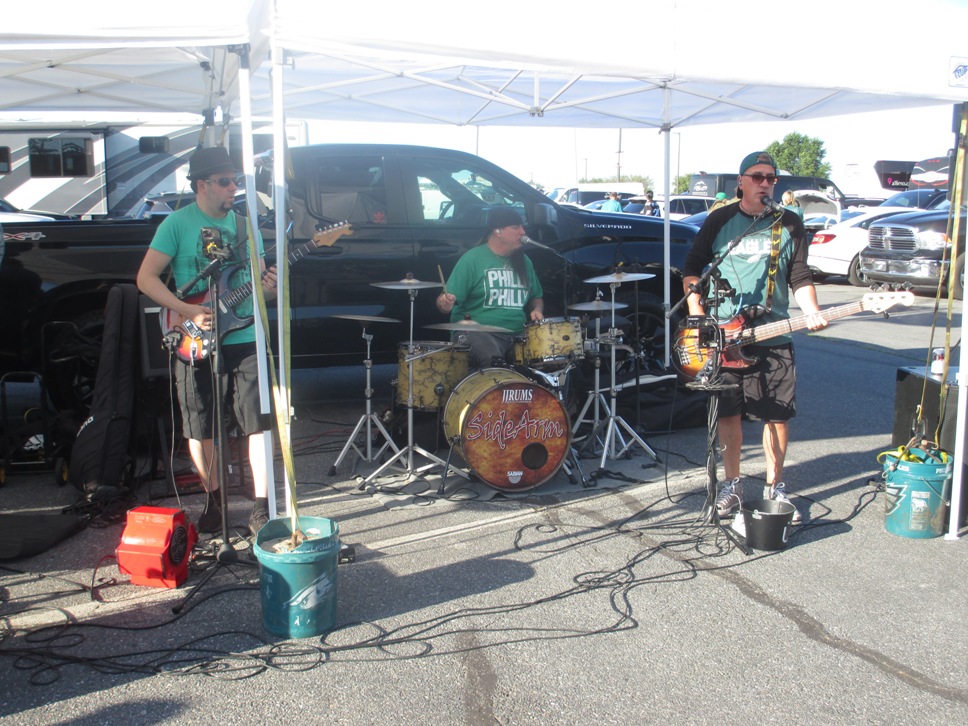
This band was playing Van Halen’s “Unchained”, and the guitar player handled himself quite well. It’s no place for amateurs.
It’s even an opportunity for catering services, private event coordinators, DJs, even live musicians, all of which you can easily find at an Eagles tailgate.
If nothing else, fly a plane towing a banner over it all for the thousands in the lot to see…which also happens frequently.
You get the idea, but even if you’re a realtor or a financial advisor, there’s no reason why you can’t build goodwill by renting a camper, hosting a game day party and inviting your customers, as one business owner (who asked for her name not to be shared) does.
No doubt, your Eagles fan patrons will speak well of you.
Because after all, you’re family.
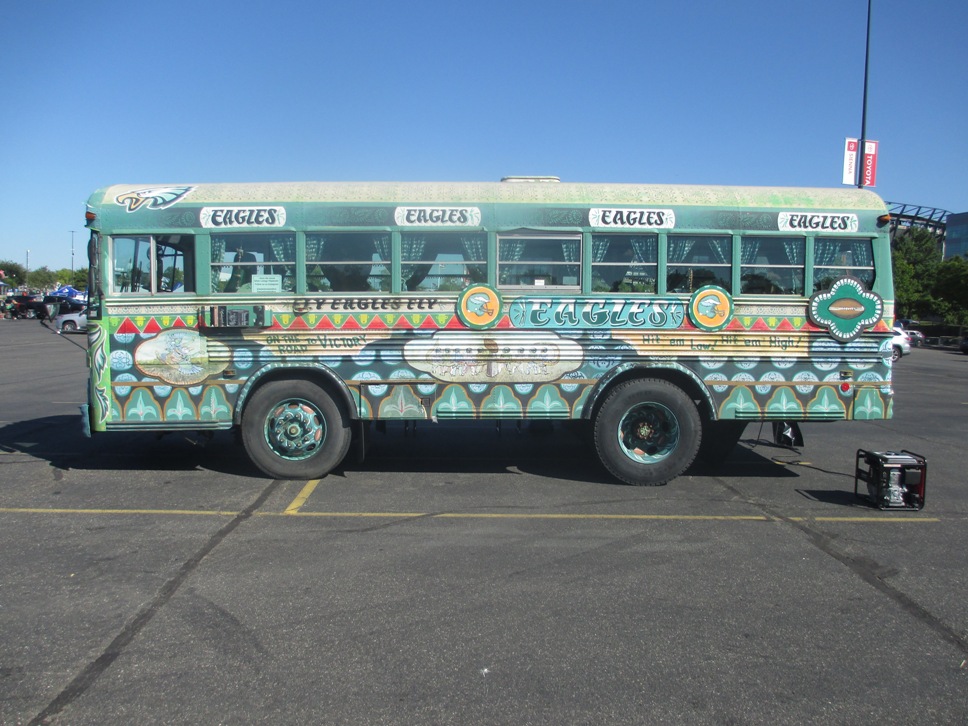
As seen on the movie screen!
As Seen In The Movies: The Silver Linings Playbook Eagles Bus
If you’ve ever seen the movie Silver Linings Playbook…and if you’re a Philadelphian, you should…you likely remember the scene where the Eagles-decorated “Asian Invasion” bus shows up in the Linc’s parking lot on game day.
In the scene, protagonist Pat Solitano Jr., has just been released from a mental health facility for bipolar disorder. At the game, he notices that his therapist, Dr. Cliff Patel, has emerged from the bus.
He catches up with Patel…whose face is painted green and silver…and Patel dispels any concerns about their meeting outside of the facility: “Today, I’m your brother in green, not your therapist.” Soon, the two have a discussion with Pat’s friend about what the Eagles strategy for the game should be, punctuated with hilarious foul language.
After the movie was made, no one really knew what to do with the bus, and so a movie hand decided to sell it on Craigslist.
Bill Curley, a long, long time veteran of Eagles tailgates, went for it, and today the Asian Invasion bus is parked in the Wells Fargo lot for every Eagles home game.
“One of the people working on the movie ended up with the bus, and nobody wanted it,” Curley remembers. “The Inquirer wrote an article about how the bus was for sale prior to the Super Bowl. Once they won it, I called the guy on the phone and said, ‘hey is the bus for sale?’ and he said yes.”

The author of A Great Number of Things enjoys some time in the Asian Invasion bus.
Curley bought the bus for $9,000 in 2017. He estimates that he’s put a total of $30,000 into the investment. The bus is comfortably remodeled inside, with cushioned benches and Eagles decorated chairs, offering a spot to escape weather that can be trying in this part of the world any time of year.
“I come here early and park right here at the end, so people can take pictures. It attracts people from all over the country, I’ve had several people from Canada. A lot of ‘this is my first game, I’m from Utah, it was a birthday gift,’ they come and introduce themselves. It’s a neat thing.”
He still gets into the party, showing up early, saving spots for family and friends, and cooking sausage and peppers for whoever shows up. He was at the Linc at 11:30 AM for the Thursday evening home opener. “It starts early and it ends late,” he laughs. “My daughter’s coming today with her friends.
“This isn’t the most comfortable thing to drive in traffic, so I leave early.”
If you’d like to see the movie scene, you can search for “Silver Lining Playbook Eagles Tailgate Scene” on YouTube. And the next time you’re at an Eagles home game, check out the Asian Invasion bus…it’s well worth a look.
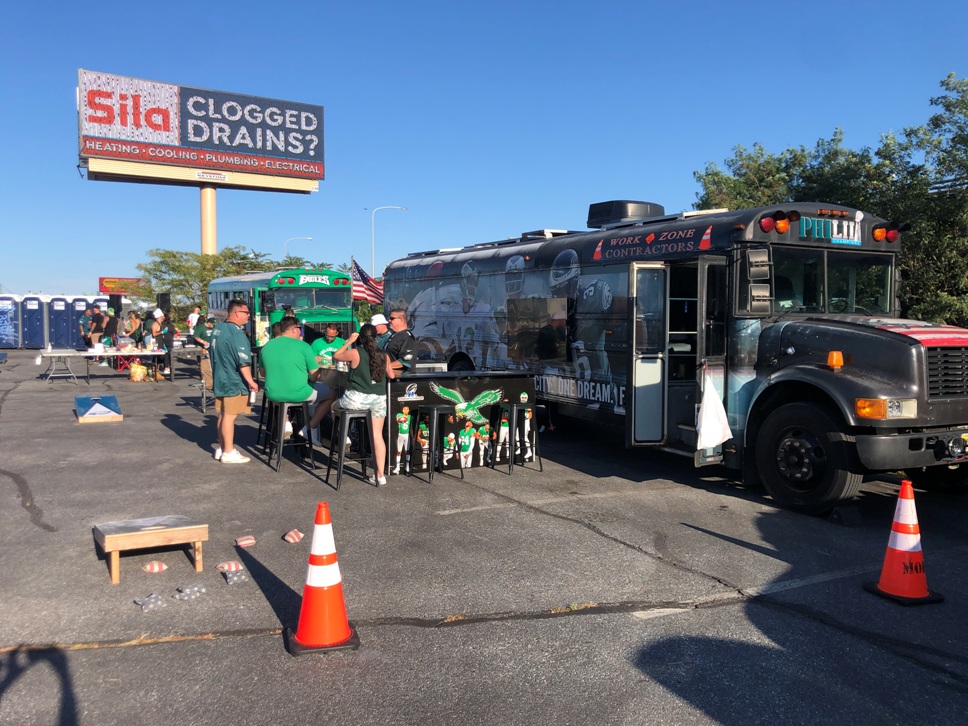
They mean it in the Jetro lot.
The Jetro Lot
While the Eagles tailgating scene is a thing to behold throughout all of the parking lots, some lots are at a different level of enthusiasm than others, and the parking lots at the Jetro Warehouse east of the Linc are undoubtedly the wildest.
To Philadelphians, the name “Jetro” is probably more known for what takes place in their parking lots than for what they do…they are a wholesale restaurant supplier, selling catering supplies and food preparation equipment to caterers and restaurant owners throughout the region.
But it’s likely that their most important…and maybe profitable…contribution to the city is their ample amount of parking spaces in the Sports Complex. The Jetro folks are, needless to say, aware of this, and they even have Facebook and Twitter pages dedicated expressly to their parking offerings for Philly sports events.
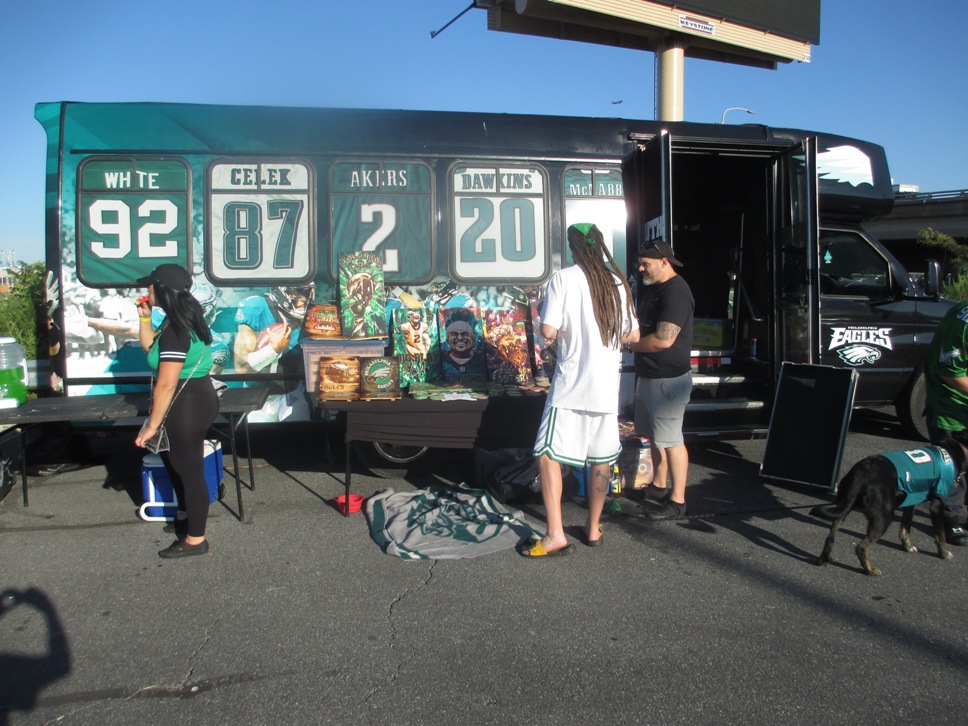
The art stylings of Jonathan Metz.
The most serious of Philly tailgaters seem to congregate at Jetro. In this observer’s visit, just a small sampling of things to see were a large number of beautifully decorated buses, a gentleman by the name of Jonathan Metz selling superbly Eagles-themed woodworks, coasters and other items, and a live band whose guitar player could mimic Eddie Van Halen’s licks quite well. That’s a ridiculously small sample, but magazines have space limits.
Jetro’s lot isn’t a place where you’d want to bring the kids or your church group. It’s loud and raucous, with music that often features lyrics full of f-bombs. There’s also a few flags that are openly critical of the current occupant of the White House, and not in a polite way.
But if you can handle that, and you truly want to show your Eagles fan dedication, the Jetro lot is likely the destination for you. It’s well worth a visit, if only just to see the level of fandom the local football team inspires.

It’s A Dog’s Life – Animal Aid USA
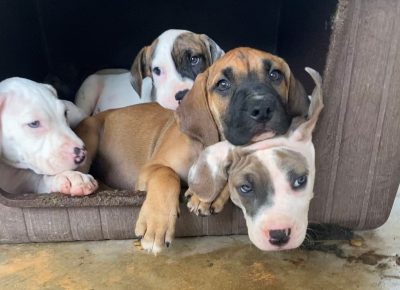
The volunteers at Animal Aid USA take a trip to rural Georgia every four weeks, to rescue stray and abandoned dogs and give them a home. To date they have rescued 40,000 dogs from unimaginable conditions. This story appeared in the spring 2023 issue of JerseyMan, you can read the magazine version here.

You want to give them names already, don’t you? (photo courtesy of Karen Talbot)
It’s A Dog’s Life
Our canine friends teach us one of the most important lessons of life: it’s too short for anything less than unconditional love, compassion and forgiveness, all the time.
Karen Talbot, Rachel Monaghan and the volunteers at Animal Aid USA have taken that lesson to heart. Their mission is to return the favor of unconditional love, to as many dogs as possible.
As anyone who participates in their rescue caravans can tell you, it’s a big challenge. Talbot herself says it’s not for everyone. “It’s grueling on that road.”
Animal Aid USA gathers volunteers, vehicles, water bowls, blankets, crates, and whatever else is needed, for a trip to rural Georgia from Williamstown every 28 days. They then gather abandoned dogs from local shelters in the area, load the dogs into vehicles, and take a 16-hour overnight drive back to New Jersey, to place dogs with no-kill shelters to be adopted.
A 64-word paragraph can’t begin to capture the level of effort involved in the operation. Monaghan, a regular volunteer, describes the process:
“We leave at 6:00 at night and arrive in Georgia around 9:00 AM the next day,” she explains. “Once we get down there, we prepare our vans with water bowls and line all our crates. If we have litters of puppies in our vans, we’ll extra line the crates, because we have to usually change them while we’re driving.
“That’s usually on a Thursday. Friday is when we do all of our preparation. In the morning, we’ll clean kennels again, and then we prepare for transport. We usually have about 30 crates in each van, we put in puppy pads and towels or blankets in all the crates. Karen tags them all, so we know which dogs are gonna be in our van. We prepare extra water bowls, extra towels and stuff to clean up any messes that happen.”
“At around 4:00, we start the load, we’re out of there by 5:15. Everyone’s just going in every direction. It’s like all hands on deck.”
Talbot, who spends much of her life preparing for the trips, likens it to a Broadway production.
“All of the preparation and the dress rehearsals and everything that you have to do lead up to one moment, and that one moment is “It’s load-up time”. That’s when everything has to be done done done, because the first dog in is gonna be in there the longest, and it’s all about getting them all in the right crates, and making sure everybody fits.
“Once they’re all in, we do our giant prayer circle and we’re off.”
The crew of vehicles with its precious cargo, including the rig mostly driven by Talbot’s husband Dante, then drives through the night…the only time D.C. traffic on I-95 is avoidable…back to New Jersey, where dogs are unloaded and placed with Animal Aid USA’s adoption partners. The project is both exhilarating and exhausting.
“Then you get home and you crash,” Monaghan laughs.
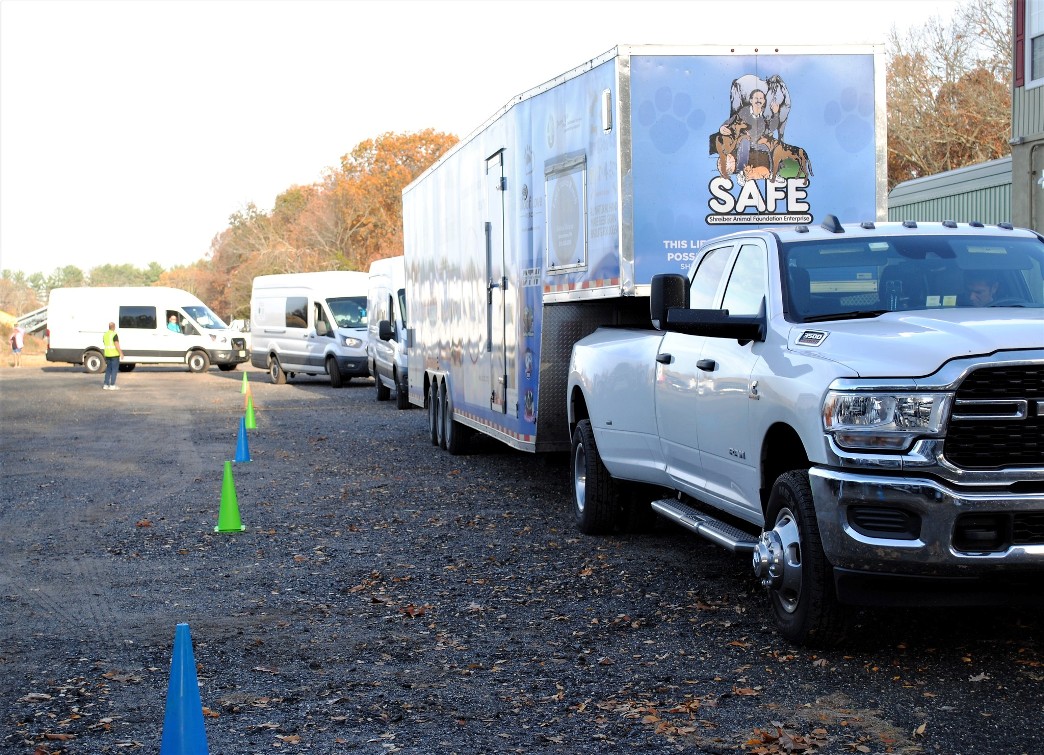
A truck full of dogs headed to be adopted in NJ. (photo courtesy of Karen Talbot)
So why rural Georgia, 16 hours away, every four weeks? Surely there are plenty of stray and abandoned animals in New Jersey?
Probably. But in Georgia and several other states, many rural counties don’t have the resources to care for stray dogs. Sadly, it isn’t often even for a lack of funding. There’s simply a different attitude towards dogs in the places where the caravan goes.
It was quite the culture shock for Talbot, as it would be for any animal lover.
“Animals are not viewed the way they are up here,” she says. “They’re not household pets, they’re not family members. They are yard dogs, they’re a nuisance.
“They don’t have the same empathy and compassion. The majority of people could care less about animals, and the minority of animal lovers are really fighting a bad war.”
She remembers witnessing how the situation reaches a tragically mind-numbing level for many people.
“When I first started going, I was so angry with them at first. Like, ‘Wait a second, you mean to tell me that you love animals, but you drove past a litter of puppies on the side of the road? What the hell kind of an animal lover are you?’
“But as I got to know these people, I realized they have 40 dogs at their house because they stopped 40 times, and now they can’t feed their families, now they don’t have food. They’re being threatened with eviction, they’re being threatened with divorce. They have to put blinders on, because sadly that’s where they live.”
Like all of the volunteers, after being a part of so many caravans, Monaghan has seen heart-wrenching stories of dog abandonment too.
“There was a case where, I guess the person went to jail, there were these Chihuahuas. The house had to be condemned. It was so disgusting, they were living in layers of poop and pee, it was just horrible. And again, the police, they didn’t want to deal with it.”
Monaghan laments that “All the shelters are pretty much kill shelters. None of them do public adoptions or rescue. If they’re not claimed by their owner, they usually get euthanized.”
Talbot describes the horrific conditions that dogs endure. “They’re not even shelters. They’re death holes. They’re a cinder block hut with a car port over top that they call a shelter. There’s no A/C, there’s no heat, some of them don’t get fed. They’re just there to hold until they’re killed.”
Hearing the stories can take an observer from “Why do people do all of this to rescue dogs?” to “How can anyone with a heart not do something?”

Rachel Monaghan (right) with a new bestest buddy. (photo courtesy of Rachel Monaghan)
In Rachel Monaghan’s case, she wanted to do something to overcome her grief after losing her own dog unexpectedly. She learned about Animal Aid USA through a friend, and has been hooked ever since her first trip.
“I was planning on going to three trips that year,” she remembers, “and I ended up going on I think six. I just became a regular caravan member.
“The best part for me is seeing the transformation. Obviously it’s awful what they go through, but seeing the resilience of them, and how they just still continue to love and trust people.”
Talbot says of the people giving their time to the caravan, “I’ve discovered that it’s not just them saving dogs. This movement has saved them. It’s saved their marriages, it’s stopped them from drinking, it’s made their life better at home. It’s their outlet to get away for a while to do something bigger than them.
“Nobody gets that until you come on a trip. Our motto at camp is ‘Our strangers leave as family’. And it happens to everybody. If you have a soul, it happens to you. It can’t not.”
In the face of a mentality that has existed for generations in this part of the world, Talbot and her team have taken on the most difficult of tasks: not just rescuing dogs…over 40,000 of them now…but also changing an established mindset that creates the need for their rescuing.
“You see it, in just the blank stares,” Talbot says. “People cannot believe that first of all, we would drive that far for a dog, and second of all, why?
“What we’ve learned is with our continuous journeys there, and the trust that we’ve built with these people. They know we’re not there to do anything except help. We want to change the next generation, we want to break this cycle, which we are.”
Talbot has seen that transformation in personal relationships, such as with a hardened animal control officer who now reaches out to Karen for help with dogs he finds.
“We laugh about it today,” she reflects. “When he first met me, he grunted at me, wouldn’t even make eye contact with me. I said look, I’m not here to point fingers, I’m here to help.
“A couple of years went by and he started to talk to me, he gave me his cell phone number. Then a couple of years later he was just like, ‘Hey, Karen, listen, I got so and so dog that just came in, you think y’all can take this one?’
“And this relationship blossomed. Plus some Tastykake cupcakes from up here helped too,” she adds with a chuckle.
Karen Talbot doesn’t spotlight her own role in rescuing dogs, even though it’s considerable. To her, it’s simply her life’s work. She always emphasizes the word “we” when speaking of the efforts of everyone involved.
“I had an idea, and I had a vision, but a vision is just a vision unless an army comes together to actually make that vision become a reality. We’re all volunteer, it’s just a life-long mission of ours.”
By providing the education, awareness and resources, she says, “We are empowering the next generation to make change in their world for companion animals. You’ve got rescue groups all over. But are you changing the mindset while you’re doing it?
“We are, and I think that’s what I’m most proud of.”
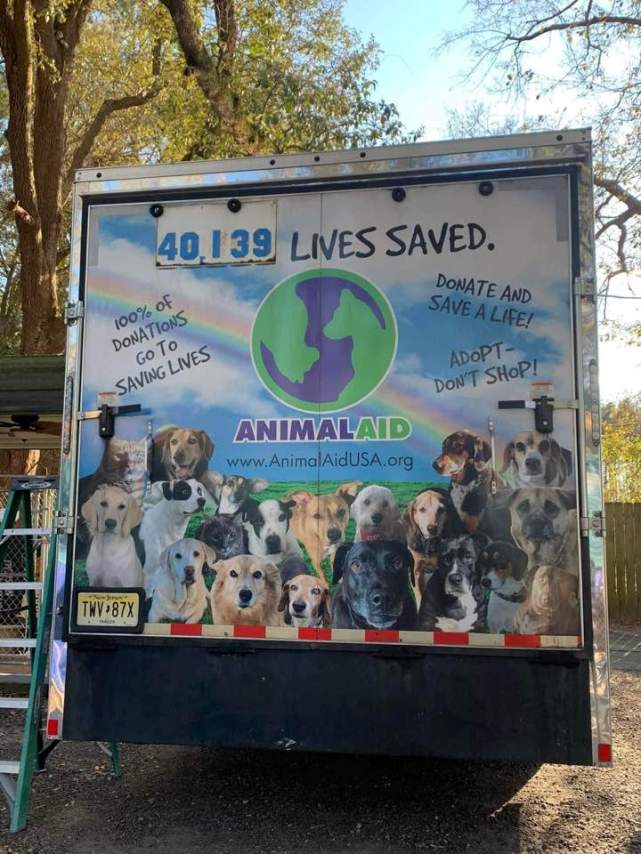
And counting. (photo courtesy of Karen Talbot)
An Animal Loving Bachelor
The rescue caravans at Animal Aid USA operated under different names in its early years, including MOMS (Making Of Miracle Stories) Rescue and Paws For A Cause, as Karen Talbot worked to raise awareness of dog rescues in rural Georgia.
Talbot fondly recalls the story of the huge contribution from Lorenzo Borghese, a name you may know…he was The Bachelor in the show’s ninth season. Borghese is an animal lover himself, and he wanted to help when he saw a documentary about the rescue operation.
As Talbot understood, his endorsement meant far more than a financial contribution he could have made.
“I was contacted by somebody who knew Lorenzo,” she remembers. “They wanted me to get introduced because (Talbot’s husband) Dante and I had started to take trips to Georgia. We went on our first trip in January of 2011, and on that trip, we had a borrowed van and we went down for 23 puppies.
“Once I met with Lorenzo, what I loved about him was there weren’t layers to get to him. He was the real deal, he reached out to me personally. I gave him a copy of the documentary which we had done.
“He knew that Dante and I were going back and forth to Georgia and funding everything on our own dollars and credit cards. Once he left our meeting he went home, watched this 25-minute documentary and was hooked.
“He said, ‘Are you looking for a check? Are you looking for money?’ I said, ‘No, I don’t want your money. I want something more important. I want a voice. People know who you are, they recognize you, they don’t know me.’”
Borghese suggested creating Animal Aid as an umbrella for MOMS Rescue, which he then lent his endorsement to. The “USA” was added when they learned that another “Animal Aid” already existed.
“That’s when Animal Aid was born, and so we incorporated Animal Aid is a non-profit. All the while, I still kept Making Of Miracle Stories, and Animal Aid just took off.”
Borghese adding his voice undoubtedly helped the effort. Talbot made a wise choice asking for it over a check…which she says would have been spent in a week and immediately forgotten.

Being adorable in their natural state. (photo courtesy of Karen Talbot)
The Video
On the Animal Aid USA website, you can watch a video of their being featured on “To The Rescue” docuseries, with host Tommy Habeeb narrating the full experience of the caravan going back and forth from Williamstown.
The video shows the Georgia compound where dogs are held until the caravan arrives, as well as the medical facility where vets handle spays, neuters, and heartworm treatments. Habeeb hears about the entire process from Talbot, who describes the logistics from dog food deliveries to the 38-foot transport rig that holds 64 crates.
Throughout the video, you see Georgia dogs in their natural state of being adorable, making the work that Talbot describes as grueling seem not only worth the effort, but not difficult at all. But Talbot shares that people are exhausted by the end of the project, wondering what they’ve signed on for, until the sun comes up during the ride home and they see the light at the end of the tunnel.
The caravans could easily be a reality show, you might think while watching. But Talbot is quick to shoot down pitching the idea of a reality show to a network, as this writer suggested.
“It’s a real reality show every 28 days down there,” she says. “But for me, living it on a daily basis and being in Georgia…Rachel’s amazing, it’s not a bad idea for her to set up a YouTube channel with a following, where we are real and raw.
“You’re not getting raw in reality TV. And you’re also controlled, and it’s scripted, and I am the furthest from being controlled or scripted.
“They don’t like that at all!” she says with a laugh.
The video is well worth a watch…go here to see it.
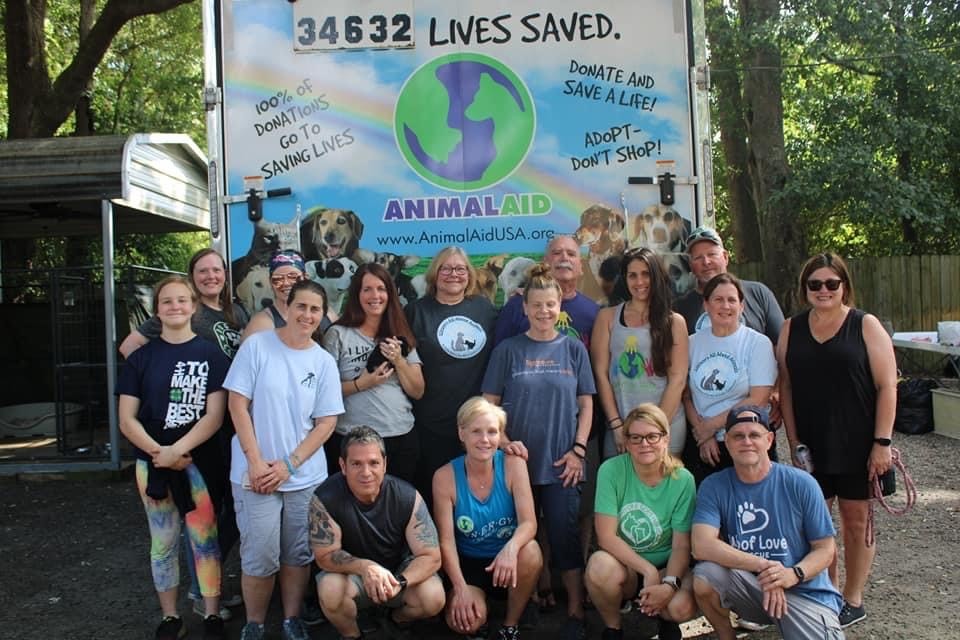
You are welcome to come join them. It’s life transforming. (photo courtesy of Rachel Monaghan)
Put It On Your Bucket List
Karen Talbot and Rachel Monaghan were happy to invite this observer to join them for a caravan trip. It’s something to consider, even if you just like long overnight road trips and need a worthwhile reason.
As Talbot says, the caravan has even saved marriages, and she cites her own as an example. Her husband Dante, who now drives and maintains the big rig of the caravan, had at one point tired of her devotion to the cause and requested a divorce.
“I immediately chose the dogs,” Talbot says.
“The following summer after the giant Georgia puppy caravan, we then had our documentary premiere in Philadelphia, and all the people that came on the caravan…the pilot, the rescue groups, everybody, was in attendance at the Trocadero.
“Dante was there because we were still friends, and he saw what I was doing from our bedroom on a computer, and he vowed to make it up to me the rest of my life if we got back together.”
The power of puppy faces. “It’s really funny because the reason we divorced was dogs, and once we re-married and got back together again, he’s worse than I am with dogs.”
Hopefully your marriage isn’t in need of helping dogs to save it, but if you’re interested in lending a hand and the life transformation that all of the volunteers speak about, you can reach out on the Animal Aid USA website and see if they need help with the caravans, which they usually do.
“Put it on a bucket list at least once in your life,” says Talbot.

Foodie Hall in Cherry Hill

The best assignments a writer could ask for are the ones that include free food…but especially when that food is from recipes concocted by gourmet chefs. JerseyMan sent me to cover the opening of FoodieHall in Cherry Hill…a great place for outstanding grub. Check out the article from the magazine here.
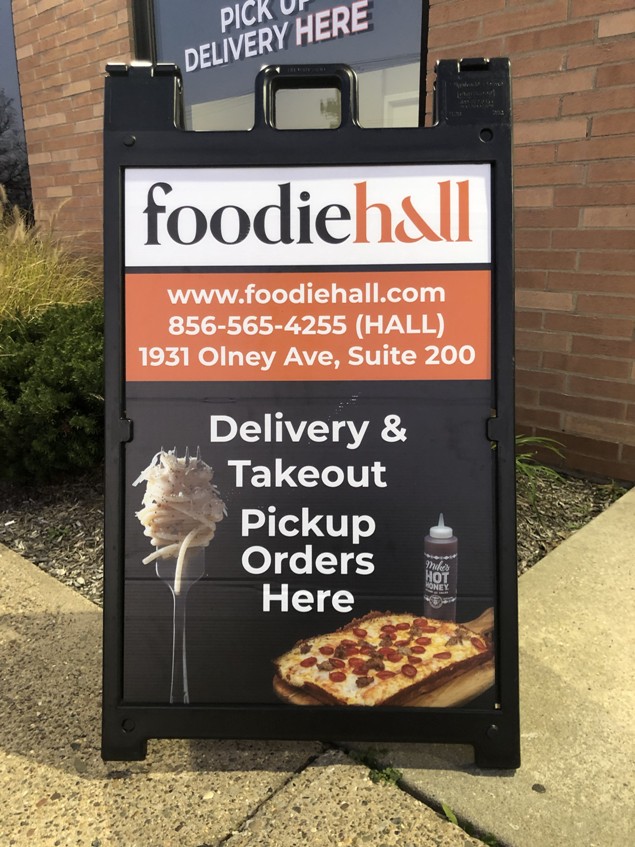
Hall of Food
The new Foodie Hall in Cherry Hill is a revolutionary concept – first rate food prepared specifically for takeout and delivery, while offering something for every taste.
For you JerseyMan readers and Legacy Club faithful, since membership has its perks, we’re about to share privileged information with you. If you’re on a plane or train, check that no one is looking over your shoulder, and that there are no surveillance cameras nearby. We’re entrusting you as someone with a need to know.
Here it is: You can now get a Geno’s cheesesteak in South Jersey.
Okay, maybe it doesn’t sound that momentous. Tony Luke’s, Primo, DiNic’s and other iconic Philly sandwich shops have all opened outposts across the Delaware, sparing their enthusiasts in our neck of the woods considerable congestion.
But for Geno’s, expansion from its 56-year South Philly location has been minimal. You can find a couple of locations in the city, like the airport. But until very recently, a Jersey dweller had to pay bridge toll to sample a Geno’s cheesesteak.
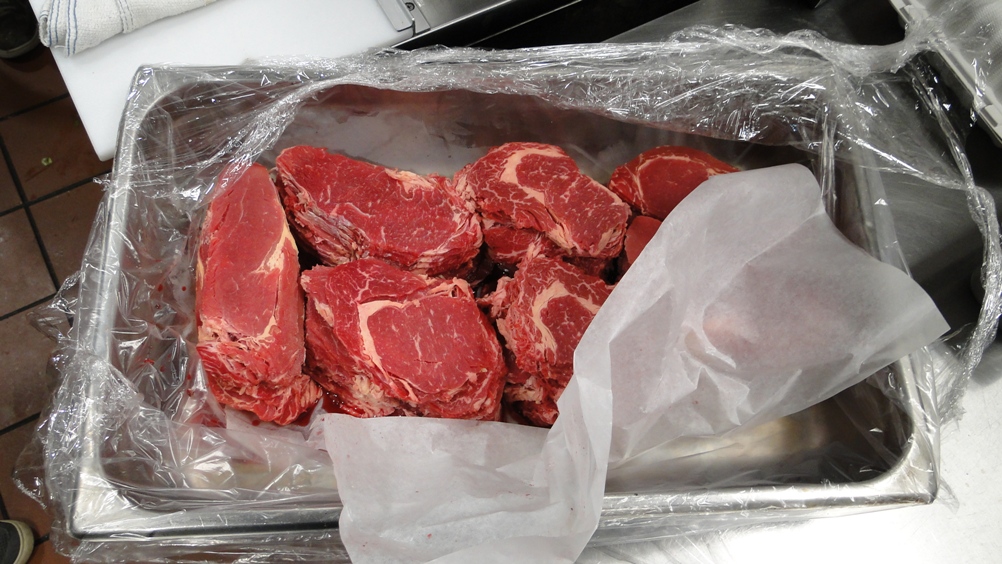
It’s the meat. Geno’s won’t have it any other way.
Dan Goldberg, co-owner of the Foodie Hall in Cherry Hill that now offers the essential Philly sandwich, helped to make this unprecedented happening possible.
“We’re very excited about it,” Goldberg says. “Our PR firm had a relationship with Geno, and made the introduction. We pitched Geno on the idea, and surprisingly to us, he was receptive.
“Geno’s has never expanded outside of Philadelphia, ever. So for us, this was a really exciting opportunity. Geno toured our facility, was very impressed with the layout, the cleanliness, and the whole thought that we put behind it, and said he was interested.”
And so you know, Goldberg didn’t just throw a few bucks at Geno Vento to use his signage. Thankfully, Geno is more protective of his brand than that.
“We worked out our deal, and went through extensive training with Geno to make sure that the Geno’s steak you have here in Cherry Hill is the same Geno’s steak you’ll have in South Philly. Which is not only important to us, but obviously important to Geno as well. It’s literally his name on the marquee.
“Geno was adamant, because he’s approached all the time, he wants to make sure there’s consistency across his locations.”
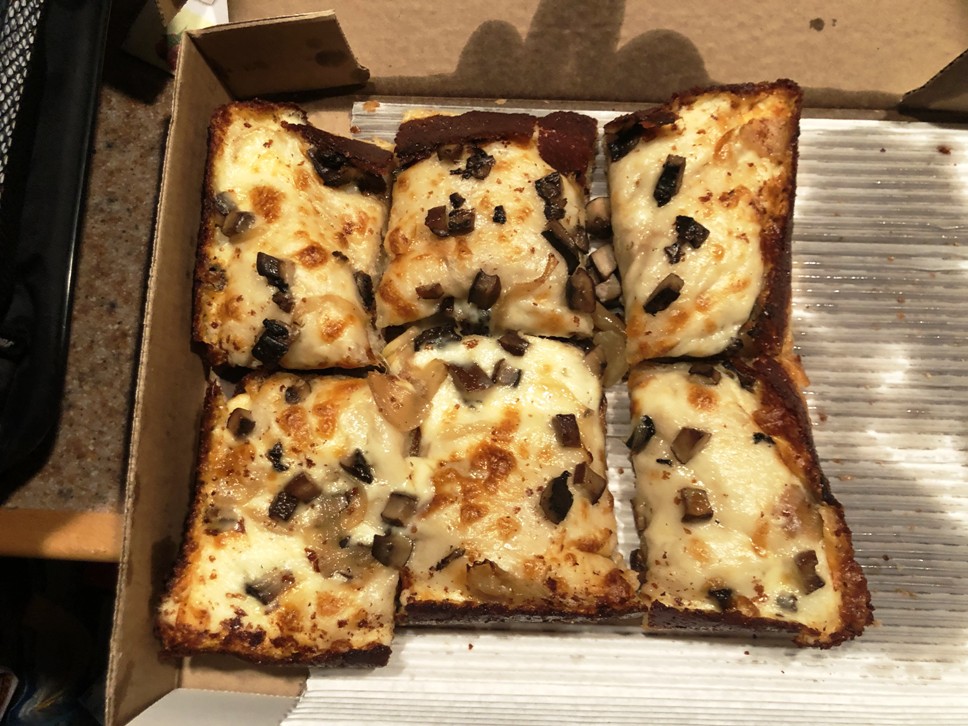
Not just Detroit-style pizza…Detroit-style pizza created by a gourmet chef.
To successfully persuade Geno’s to be a part of Foodie Hall is obviously a significant accomplishment. But it gets better.
Foodie Hall opened for business in May of 2022 offering a novel idea…multiple types of cuisine available for takeout and delivery. No more settling, they proudly proclaim. If your family bickers frequently over what to get for dinner, or your sports watching buddies can’t decide between pizza or burgers, Foodie Hall is your solution.
To be sure, maybe any-cuisine food delivery isn’t what you’d call a novel idea these days. As many restaurants in New Jersey were forced to close in response to a virus, many of them were offering takeout and delivery options to stay viable. If your local diner was doing this, you could probably choose from a varied menu and have DoorDash or GrubHub bring it to you.
Foodie Hall is revolutionary in being designed for the purpose of delivering higher quality food…whether it’s tacos, chicken sandwiches, or dumplings. Hop onto their website and order from menus that include Detroit-style pizza, Korean BBQ burgers, chicken Quesabirria burritos and much more. All chef-inspired creations.
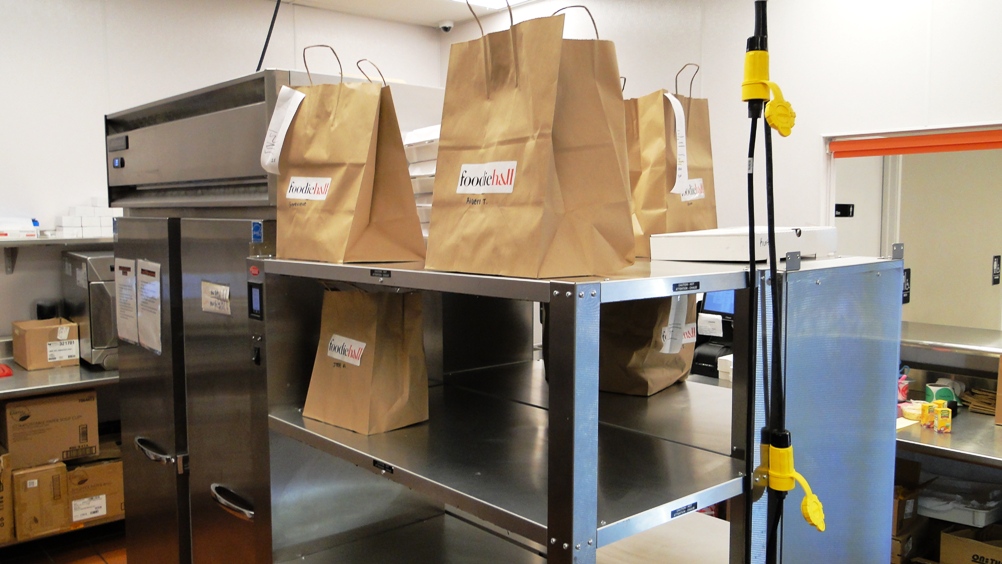
Since the pandemic, the trick is to keep food warm.
In case you’re wondering, Foodie Hall wasn’t conceived during the pandemic. But the sudden pivot towards takeout and delivery definitely gave the idea a boost.
“In 2018-19,” Goldberg remembers, “my original founding partner (Nick Ballias) and I, we met at a food event that I co-chair, called Men and Women are Cooking, that raises money for the Atlantic City Boys and Girls Club. This was when GrubHub, Uber Eats and DoorDash had come to Atlantic City, and it was starting to blow up.
“We started coming up with an idea for a delivery-only restaurant. We had penciled this out already, and then Covid hit and restaurants closed, and all of a sudden everyone was ordering delivery.
“My parents were telling me how they had ordered Morton’s for dinner. That’s when it struck me, there are people whose consumer habits have now changed and will never go back. It’s no longer just wings and pizza. There’s my parents, who are not exactly the most tech savvy, ordering steaks for dinner, that means anybody can be ordering everything.
“So why not come up with a restaurant concept that had multiple different types of cuisines on it? We ran into this family idea, where the parents want adult food and the kids want pizza or mac and cheese. Or the parents can’t agree. Or you have a group of friends watching football and they all want something different. Rather than settling, let’s have something for everyone.”

The conveyor belt. It seems so obvious if you’ve owned a dry cleaning business.
Sounds great, but how could that all work? A conveyor belt is a big part of it (!), but Goldberg says every step of the process matters.
“We put a lot of thought into what delivery trends were taking place, what was working and what we saw that wasn’t working,” he remembers. “Packaging was a big piece of it. Many restaurants during the pandemic that were doing delivery kind of out of necessity were using takeout packages. Those packages are not meant necessarily to be reheated, or to be leak proof, or to sit in a car for half hour or to retain heat or cold.
“We looked at packaging specifically meant for delivery. We wanted something that would maintain heat and not leak. We literally made products in our kitchen, put them in different containers, and had them sit in our parking lot for half hour or drive around and see how they held up. We wanted packaging that would be eco-friendly, and also able to be reheated in microwaves and ovens and things.”
Then there’s the little matter of creating a wide variety of cuisine from one kitchen, maintaining quality, and somehow keeping overhead down.

Some ingredients are astoundingly versatile.
“We are very conscientious in the ingredients we use to be cross-utilized across all the platforms. For example, chicken breast is used in multiple products across the different restaurants. I have a chicken parm sandwich at Criss Crust, and we have the chicken sandwich concept, Simply Fowl, and then we have salads that have grilled chicken on them. We’re trying to use things across and that keeps us more efficient.
“When we designed the kitchen, we were concerned with having a traffic issue, with people walking around and bringing all the various foods to the front. It would have been a waste of labor. We came up with a solution which I borrowed from my old business…a commercial laundry business…where we had a conveyor belt. It’s a 120-foot conveyor belt that runs down the center of our kitchen.
“I don’t need people running up to the front and bringing the food, I don’t have to worry about people walking into each other. It’s a way to keep costs down and keep order in the kitchen.”
The conveyor belt concept is indeed impressive to witness. An owner of a busy diner might see it and wonder how in the world they didn’t think of it.
“No one’s ridden on it yet that I know of,” Goldberg jokes.

Craft burgers. Just because craft burgers.
JerseyMan loves telling readers what makes life in South Jersey great and highlighting business ingenuity among our own. Places like Foodie Hall give us plenty to work with.
In the days before smartphone maps, you might have had a difficult time finding the place. It’s situated in an industrial park in Cherry Hill, just off of Route 70 but requiring navigation of annoyingly tricky jug handles and intersections. If it were a sit-down restaurant, the difficulty getting there might be a factor in your going elsewhere.
But for this style of eatery, the location is the beauty of it.
“We are delivery and takeout only,” Goldberg says. “We need to be near people, and we need to be near businesses, but I don’t need to be on Route 70 or Route 73. I just need accessibility, I don’t need visibility. We built out this really high-end large kitchen, with the latest and greatest in equipment, but I’m not paying the prices I would pay to be on Route 70 or 73. It’s more economical to be here.”
Market research drove the location of Foodie Hall’s first outpost in Cherry Hill. Even though it seems obvious.
“Between Cherry Hill and Mount Laurel and Maple Shade, you have a tremendous number of people that are foodies. It really fit well for us.
“It has a great mix of residents and businesses. We can cater to people in their homes at nights and weekends, and our concept lends itself perfectly to office orders and catering during the day. We’re getting a lot of offices that typically order once a week, same idea as from home. Instead of having 20 people fighting over what we’re having for lunch, now 20 people can get what they want in one delivery.”
Including an authentic Geno’s cheesesteak, without the tolls and traffic.
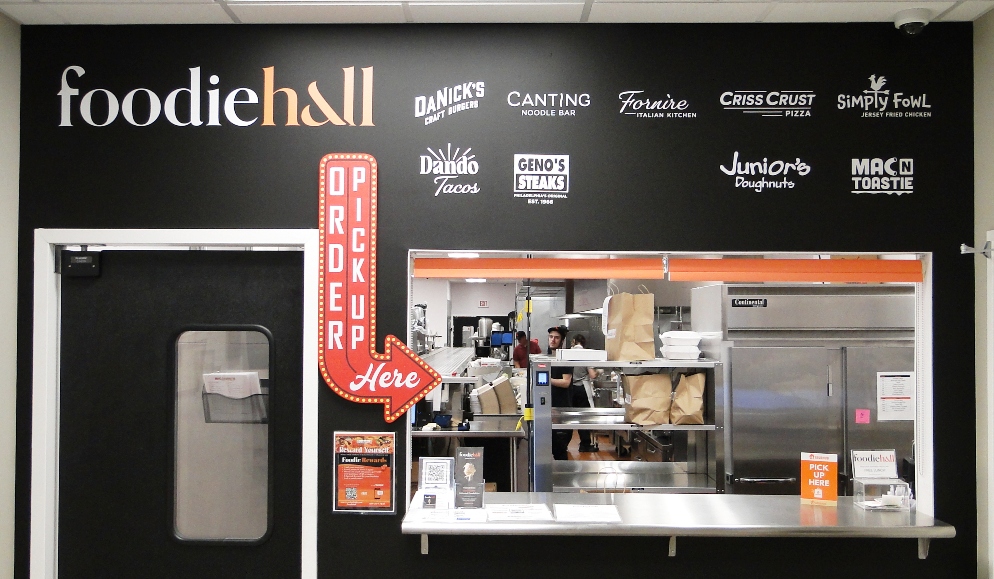
“Wow, you can get DaNick’s here?”
Establishing The Brand(s)
Foodie Hall features eight restaurants under its umbrella as this sentence was written, including Geno’s Steaks, an instantly recognizable brand to Philly area natives.
You can order Mexican street cuisine from Dando Tacos, Jersey fried chicken sandwiches from Simply Fowl, craft burgers from DaNick’s, Buffalo chicken mac and cheese from Mac N Toastie, or vegetable dumplings from the Cantina Wok & Noodle Bar. If you’re going Italian, try the Criss Crust Detroit-style pizza, or the antipasti from the Fornire Italian Kitchen.
Seeing the choices, a South Jersey food enthusiast could wonder how they have lived here so long without recognizing the catchy names and logos sitting alongside Geno’s. How does anyone miss Mac N Toastie?
When questioned whether the others are established eateries in their own right, Dan Goldberg considers it a triumph of Foodie Hall’s design.
“I’m glad you asked that,” he explains, “because they’re not. The fact that you asked that question means we did a good job of branding and trademarking to look like they are established brands. And the idea is that these brands will proliferate and open up in other Foodie Halls.
“There was a lot of thought given to the name, the logo, the design, the color scheme, to make it look like a franchise or an established restaurant. But they’re all our own creations, we came up with them. We put the menu together, the recipes, etc.”
That includes DaNick’s, which sounds perilously close to DiNic’s, the long established roast pork sandwich destination in the region.
“No, different name,” Goldberg responds when asked about the similarity. “They’re actually named after (co-founder) Nick (Ballias) and I, Dan and Nick. Nothing to do with them, we love their sandwiches, but yes, completely unrelated.”
So foodies in the area can rest easy knowing that they haven’t missed out on Fornire’s, and a potential topic for their blog.
But if you’re one of those types, the clock’s ticking on trying out Foodie Hall before your blogosphere competitors do.

You’re probably pretty good at cooking if you’re seen with this guy. (photo courtesy of Georgeann Leaming)
Key Players – Georgeann Leaming
Dan Goldberg and co-founder Nick Ballias don’t mess around when it comes to takeout fare for discriminating South Jersey natives. While working out the plans for Foodie Hall, they considered product quality important enough to bring a chef on board to be a culinary consultant, and design recipes for their menu of food creations.
Not just any chef, by the way…they partnered with Georgeann Leaming.
You may have heard of Leaming…she’s been a champion TV chef on Food Network’s Chopped, and competed on Hulu’s Man vs. Master. She’s been an executive chef for two of Gordon Ramsey’s restaurants, and has co-owned two food stops in Philly. One of them, Samwich, took Philadelphia Magazine’s “Best Fried Chicken Sandwich” prize in 2016.
That’s just a partial list of Leaming’s street creds in Philly area cuisine, but it’s enough to see why Dan and Nick would take the opportunity to work with her.
“It was very important for us to not simply have your average burger or chicken sandwich. We try to do everything higher end than your normal delivery would be.
“She left to pursue some other avenues in September, but she was with us all the way. She helped us design the menus, and some of the dishes were completely her own from top to bottom in terms of the ingredients, the recipes and everything. These are recipes that we use, and we haven’t changed anything since she left.
“Georgeann was a big help,” Goldberg acknowledges. “Fantastic, talented chef, culinary director, and really helped design and get this to where it is. Perfect person for this, and without her, we wouldn’t have the type of food that we have today.”
The decision of what to get for everyone in the room isn’t the only comestible conundrum Foodie Hall solves. If you’re looking for cuisine inspired by a top chef in the region without the triple-digit price, they take care of that for you too.
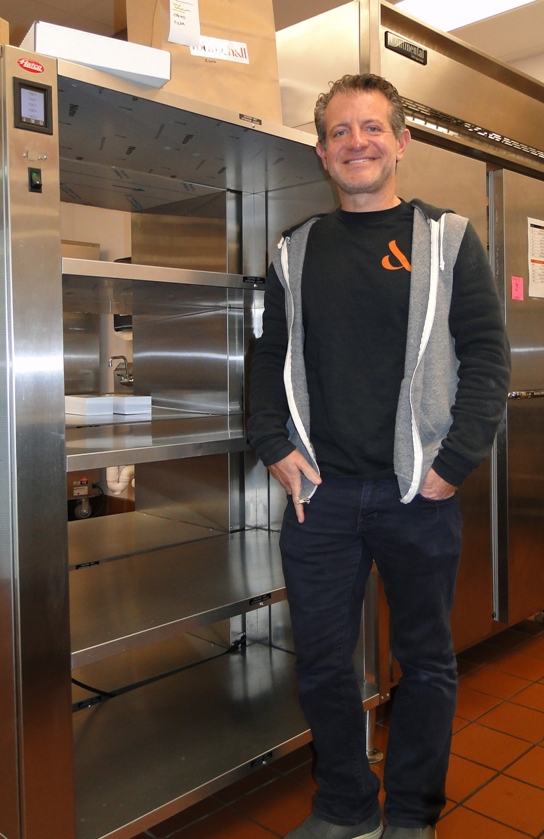
Dan Goldberg, FoodieHall co-owner, feeding people everywhere.
Meals 4 Meals
Dan Goldberg and his people consider giving back to be part of the ethos of business success, and they offer an incentive to philanthropic types who love great food. For every meal ordered from Foodie Hall, they donate a meal to Feeding America through their Meal 4 Meal program. On Foodie Hall’s website, they call the initiative “a vitally important guiding principle in how we operate.”
Goldberg is happy to explain how it works. “What they do is, they will take a monetary donation that they get a lot more mileage out of than we would, because of their immense buying power. We donate an amount to them for every meal that we sell, which is the meal equivalent for them. They use that to purchase meals for their partner charities, which are all across the country and the world.
“We initially got the idea from the Bombas Socks people. For every pair of socks that they sell, they donate a pair to people in need in a country outside of America. And we loved the idea. It made a lot of sense to us.”
So when you order from Foodie Hall, you’re not only providing all your guests or employees something for their own tastes, you’re making a contribution to a four-star organization with 200 food banks and over 60,000 programs to help feed the hungry in your own homeland. Not that you need any extra incentive to try Simply Fowl’s Nashville fried chicken sandwich, but it doesn’t hurt.
“By our calculations,” Goldberg estimates, “We’ll be donating about 50,000 meals in this year, which is really exciting. I’m very proud of that.”

Collectors And Sons – The CollX Sportscard App
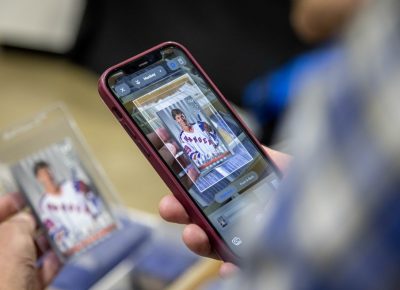
JerseyMan sent me to interview Ted Mann and talk with him about his new app, CollX, which helps sportscard collectors easily find the value of their cards. Love fun assignments like this! You can read the article on JerseyMan’s website here, or view the PDF from the magazine here.
(All photos courtesy of Ted Mann unless otherwise indicated.)
Collectors & Sons – The CollX App
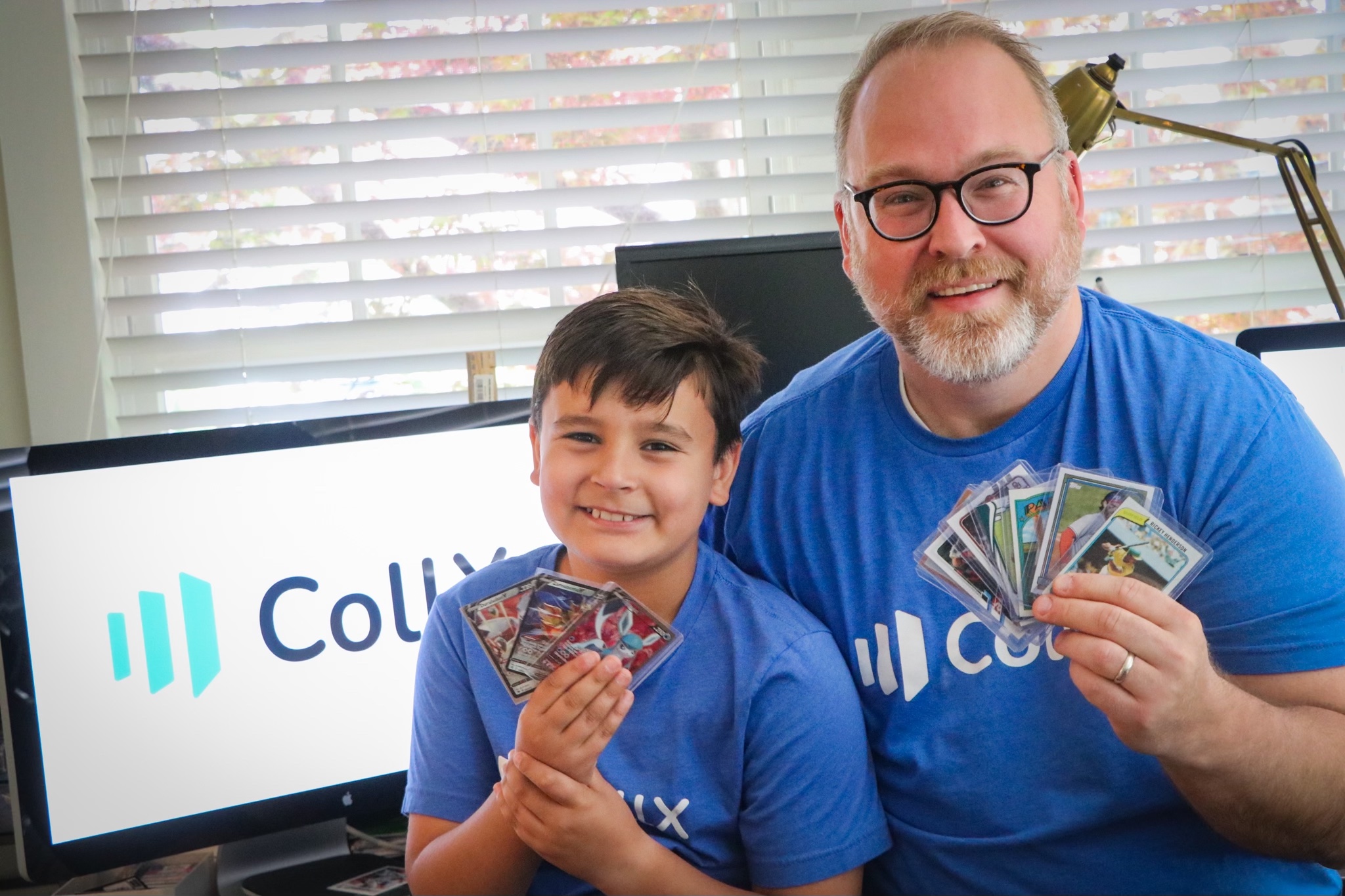
Two geniuses at work.
There is a new app available for sports card collectors that solves a decades-old problem…finding out how much your sports cards are worth. It’s called CollX, and the idea was hatched by a ten year old.
The wonderful thing about young children is that no matter how overwhelming a problem, they always see a simple solution.
And as any sportscard collector knows, finding the true value of cards is a pretty overwhelming problem.
Ted Mann, a former journalist, has just started his fourth technology company using visual search technology. It’s an app called CollX, and it’s an idea that is so obvious that adults need kids to help us see it.
Fortunately, Ted has just such a visionary living under his roof…his ten year old son Charlie, who saw how his father’s technical skills could make the world a better place.
The CollX app does the most important thing apps do…it saves collectors lots of time. With CollX, you can dig out that dusty collection of sports cards from your attic, scan each card, and instantly see its approximate worth. (Incidentally, if your cards are worth anything, hopefully you’ve been wise enough not to let them collect dust.)
No more poring through Beckett or Tuff Stuff guides, no more hauling your collection to a broker, no more countless hours on eBay. Ted and Charlie tried all those things with their collections, until Charlie suggested a better idea.
Ted gives all the credit where it’s due.
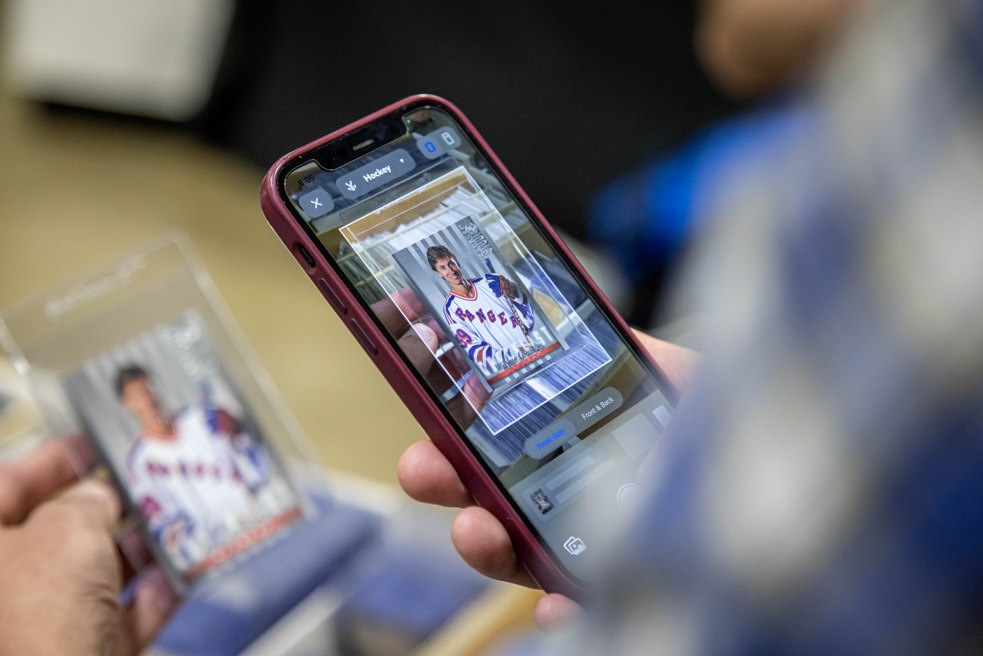
It’s obvious enough that we need a child to think of it.
“When I was a kid, I ran into the same problem that Charlie had. Tuff Stuff Magazine, listings and prices, I also used Beckett back then, looking things up manually.
“But the Beckett Guide has become like a phone book. It’s super thick. It’s really, really tough and time consuming to look these things up, and even when you do, I was finding that the prices in the Beckett Guide, probably the minute they’re published, are out of date.
“We found some apps where you could look up cards, but they were really expensive, high value cards, which sad to say, did not fit the description of my collection or Charlie’s.
“We tried one thing after another, and finally Charlie’s like, “Dad, can you just build me something that would do this?”
Cue the light bulb.

Baseball card valuation on the fly.
Childlike vision works because adults can’t believe some things can be easy, like finding the actual value of a Cal Ripken Jr. rookie card. As a result, many of us let valuable memorabilia collect dust in the attic.
Charlie provided the inspiration, but as Jersey native Thomas Edison informed us, genius is 99% perspiration. Ted is well aware of this, and he’s been putting in the sweat. CollX is all about making a difficult and tedious process easy…but developing the app itself has been anything but an easy process.
It’s not the easiest to market research, for one.
“It’s easy to go and ask people around town, do you have any cards? ‘Yes.’ Do you know what they’re worth? ‘No.’ Have you ever sold a card on eBay? ‘No.’ Why not? ‘I don’t know what they’re worth.’
“It definitely gave me optimism that there was something big here. But understanding how big a market it is was a challenge. We did assess that basically, thanks to eBay and other marketplaces. The current market size is about 5.4 billion.
“But what about all those people that have never sold on eBay? Could you get them to do it? Could you get them reacquainted with their cards and back into the hobby?
“We actually had to conduct a pretty big omnibus study to get a sense of that…just this afternoon, another news outlet called New Street published the findings of our research. The big takeaway was that there are about 85 million American adults that own trading cards.
“It’s a huge 33% of the population, and yet none of them, or I should say a small percentage of them, have ever transacted on any kind of market like eBay. The thing blocking them isn’t necessarily getting the cards graded or having access to a place to sell them. There’s still a lot of card stores, there’s a lot of online sites. It was simply not knowing what the cards are worth, and not having a good way to figure that out.
“If we can help solve that problem, then this huge addressable market can be unlocked.”
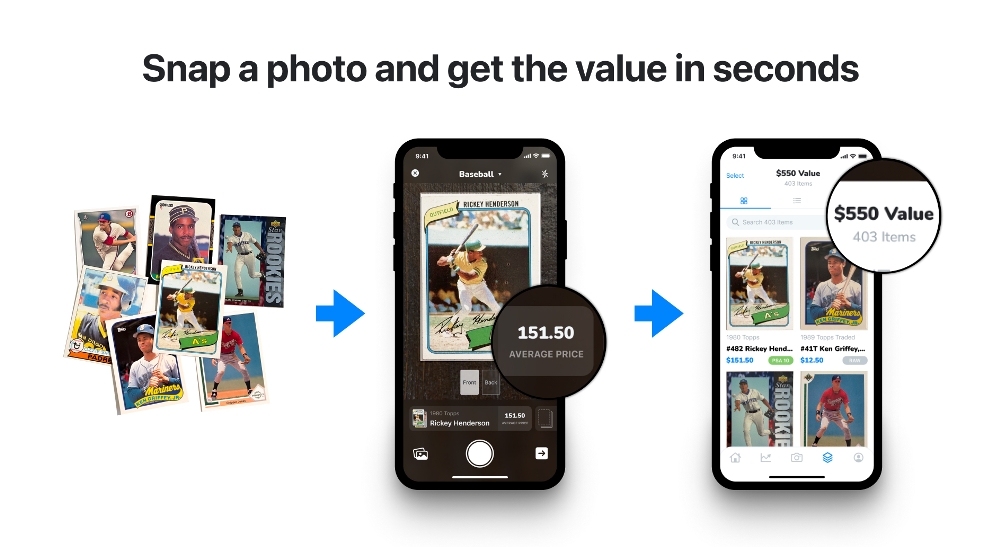
That thick book is why people didn’t bother.
There is also the sheer number of collector’s cards…the CollX database features 20 million, and most definitely counting.
It’s an ongoing process, Mann says. No kidding.
“We still don’t have every card by a long shot. There’s a few cards in my collection that I still can’t scan into CollX, because we haven’t gotten those images or gotten that data into our database yet.”
Spoken like a true entrepreneur…20 million is nowhere near enough. Just how, exactly, does a database of 20 million sportscards get constructed?
“We found a number of sites online, all publicly available sites, that have checklists. In the trading card world, you can build the set, right? And there’s a list of every card in that set. We started building those checklists, and then populating all the images for all the cards in those checklists.
“We started with baseball and then we added football, baseball, basketball, hockey, soccer, wrestling. Soon we’re gonna add trading card games like Pokémon.”
Mann says that they have also developed what he believes is a generally accurate algorithm for determining each card’s worth.
“We’ve built up a ton of pricing data, most of which is coming from other auction sites. Again, publicly available and all readily searchable, eBay being the biggest. We’re taking all of those transactions and mapping those back into the individual cards.”
Arduous task, undoubtedly.
But the CollX app keeps improving, and its usage keeps growing.

One of over 200,000 users at a given time.
During JerseyMan’s interview with Mann, a counter sitting on a nearby shelf occasionally made clicking noises and changed the number it was displaying. This counter, Mann explained, shows the number of people using the app at a given time. At that moment, the number was 232,408 and growing. There are plenty of curious collectors out there.
But Mann and Son’s E-Z Sportscard Valuation Service has bigger plans…not just helping users find the worth of their cards, but also facilitating the sale process if they are inclined, and ultimately monetizing the app through commissions.
“We’re a very early business,” Mann says. “We aren’t charging for the app. We know there are already users reaching out to other users to buy their cards…we see that happening in big numbers. We’re going to help them do that better, so we’ve created a number of tools.
“The first big tool is our deals feature, where you can negotiate on multiple cards. You can create a deal with a bundle of cards and negotiate on the lot. We’ll facilitate checkout and generate shipping labels, to ship the cards via the postal service.
“We want to help people make a lot of money on their collections. But the thing I think is really unique is, on CollX, you actually see what the buyer and the seller both have in their collections. That enables us to say, here’s the areas where you have a shared interest. If you really like the Phillies, Bryce Harper, we’re gonna surface those cards from my collection. When you add something from my collection, now here are a few other suggestions of other cards you might be interested in.
“We can build those recommendation systems in a really personalized way, and I think it creates a better experience.”
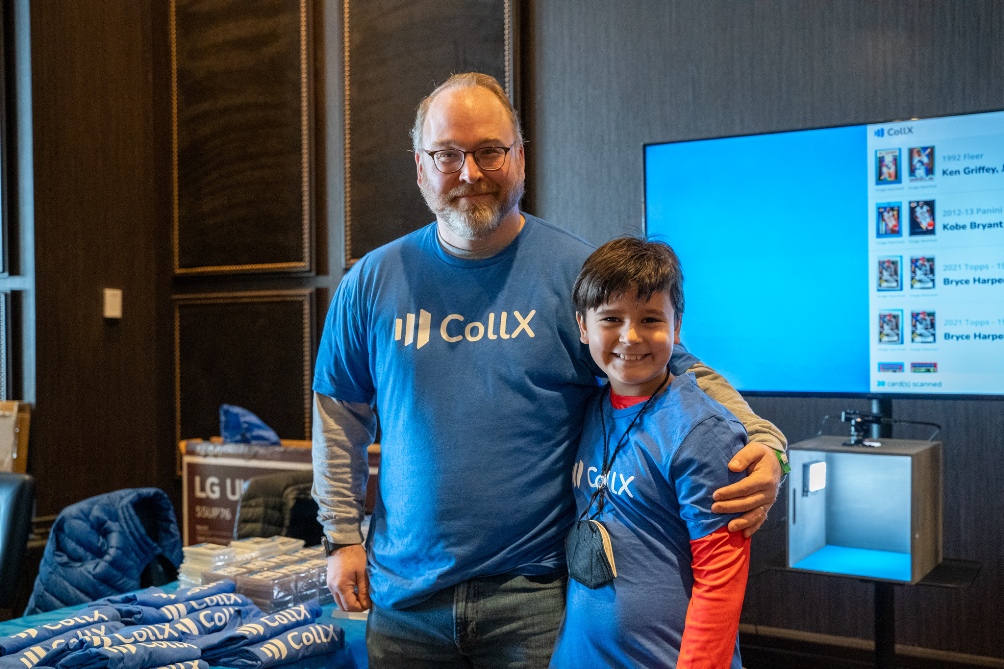
Father and son bonding through baseball cards…it’s as American as it gets.
There are few better opportunities for fathers to tell their sons about athletes of their era than when leafing through a collection of sports cards. Imagine building a business around it with your son. Charlie Mann is getting a solid grounding in both…even if he still gets more stoked about interviewing Rickey Henderson, which he did at a recent sportscard event.
Charlie is obviously not old enough to remember baseball’s greatest base thief, but as Ted says, he knows plenty about him.
“He was super excited to talk to him, because that was one of the cards that he pulled out and he was like, ‘Dad, is this one worth anything?’ I was like, ‘That might actually be the most valuable card in my collection. It’s his rookie card. Let’s go try and figure that out.
“And sure enough, it was one of the more valuable cards. So when Charlie got to interview him, he shared that story. Rickey was really nice. I was really impressed with him.”
“I love getting to do this with Charlie,” Ted continues proudly. “It’s been a great way for us to bond and connect, and it’s not just us. I’ve noticed and seen and heard from countless users on the app that it’s been the same thing for them. Just fathers and sons, getting to bond over collecting cards and to do this together. I think for Charlie that was super gratifying too. To see it wasn’t just him that had this problem.
“And he’s helping all these people.”
Sometimes, the kids really do have the answers.
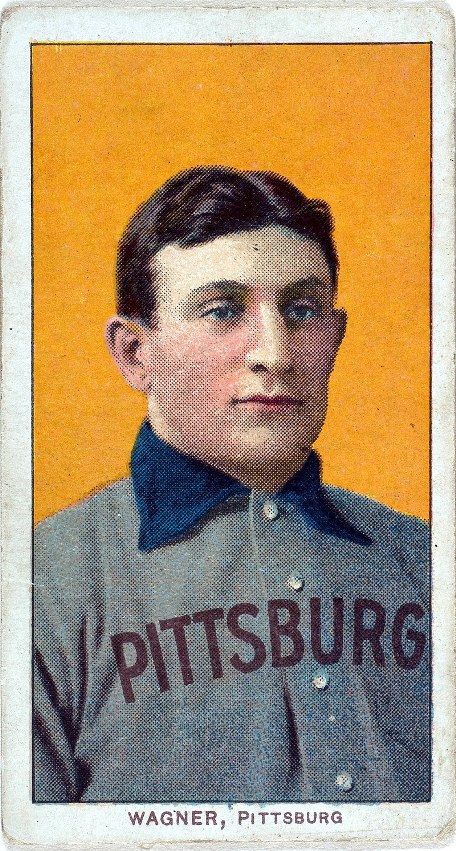
No, you can’t sell a picture of the card. (image courtesy of Wikimedia)
The Honus Wagner Card
As every baseball card collector knows, the T206 Honus Wagner card is the most valuable baseball card in history. In August of 2021, the card sold for a whopping $6.6 million.
Why is it so valuable? According to Wikipedia, in 1912 Wagner was asked permission by the American Tobacco Company, who manufactured baseball cards at the time, to have his visage included on a card. Wagner refused for reasons that still aren’t clear today, with theories ranging from his not wanting to advertise tobacco to kids to his being a tough negotiator who demanded greater compensation.
As a result, just 50 to 200 Honus Wagner cards were produced, and given his stature on a baseball field, this almost immediately made the card valuable.
Ted Mann well knows the value of scarcity in collecting. It was unintentional in the American Tobacco Company’s case (then again, maybe it wasn’t), but Mann says that card trading companies do intentionally create scarcity.
“The manufacturers of these cards create small print runs for certain cards. They’ll say, there’s only ten of these cards. It’s like your golden ticket. Golden auctions sold, I think a one of one Mike Trout rookie card for like $5 million. There’s only one of them, so that creates demand.
Mann doesn’t believe a Honus Wagner card will be scanned on CollX. He stresses that the app is more for “the rest of us”.
“I don’t think we’ll see a lot of $7 million Honus Wagner cards scanned in the collection. As much as I’d love to cater to the high end of the market and have them see the value on the app, I think it’s really kind of the rest of us, the long tail of the collecting hobby that we’re really appealing to.”
The value of some cards brings to mind a potential problem that Mann is also working to address: potential forgeries.
“It’s difficult, forgeries of cards is a tough thing to identify with just a picture, especially if they’re pretty much identical. Obviously, you wanna take a picture of the card and if for some reason you do receive a fake and you’re able to see that, you can report that. And we would not release the payment to the seller if they were peddling fake cards.
“I think there’s definitely some things that we can do to double verify it. But we will protect the buyer and make sure that they get the cards they paid for.”
Something to remember just in case you find yourself seeing a Limited Edition Honus Wergner card for sale.
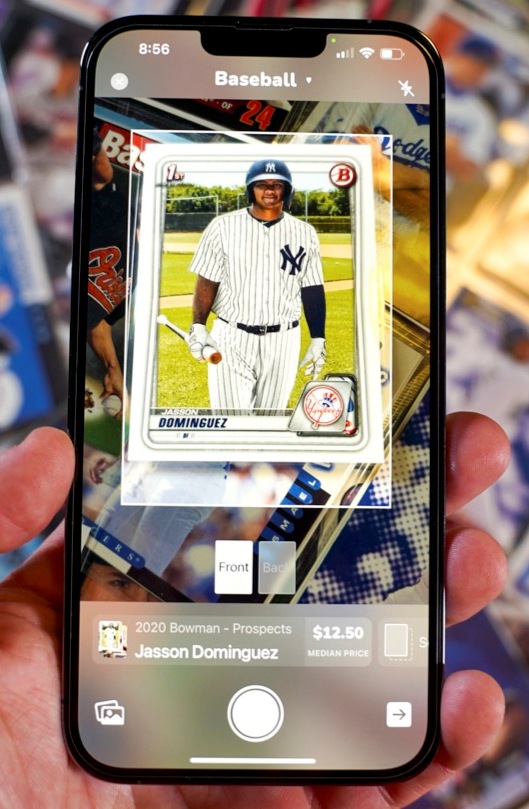
Yes, it looks like him, but let the image recognition decide.
Image Recognition – The Key to CollX
Ted Mann is an expert at how image recognition, a remarkable technology that CollX employs to determine what sports card it’s looking at. His son, of course, was aware of this when he suggested the idea of using it for sports cards.
“What we’re doing with CollX is a specific breed of image recognition that is sometimes called reverse image search, or reference image matching, where we have an existing reference image of a card. We’re trying to match the picture of the card that somebody’s taken on their smartphone to an image in our database.
“Think about it almost like matching fingerprints…when you’re matching a fingerprint, you don’t necessarily need to match everything about the fingerprint. You’re looking for the little variations that kind of define it. We kind of do the same thing. We have a deep learning model that is trained to identify specific features within each card image, and then we’re just trying to match up one to one.
“Imagine if the trading card itself was a QR code. And you’re basically just identifying that and matching that to an existing one in the database to get that one to one match.”
The explanation of the technology obviously goes much deeper, but Ted’s happy to take care of that for you so you and your son can scan your cards.

Be a part of the sportscard valuation community…
The Collector’s Community
Ted and Charlie and partner David Grzybowski recently attended a sportscard event in Atlantic City, where they were quite well received…and encouraged.
“I met probably a thousand people at the national in person who just really love the app. A couple of them came to me with a laundry list of features they’d love to see, which is great too.”
Incidentally, the audience for JerseyMan might find CollX right up their alley. “There’s a high overlap rate of entrepreneurs and card collecting,” Ted says. “It’s actually kind of a funny, it’s how a lot of them got started. I guess myself included.”
To Mann, the enthusiasm for CollX is an opportunity to improve things in the app, such as the accuracy of pricing, which has limits coming from auction sites where prices can vary.
“A lot of our data relies on eBay transactions and a lot of eBay transactions are bogus, we’ve learned. So when those happen, just helping us kind of prune those out. We’re actually gonna have an app update pretty shortly that gives some of that functionality so that our users can help us with that.
“We’ve done our best to come up with ways to average the prices or estimate the prices if needed. But the truth is we need help and we have 232,000 users, many of whom don’t mind putting in a little bit of extra effort to help us.”
Entrepreneurs who listen should be valued. CollX’s customer service is already an improvement over both of the TV providers in my area.

Steve Friedman – Champions of Cheltenham
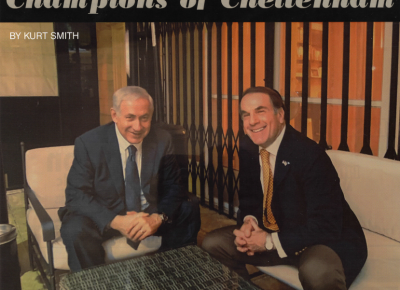
For the Winter 2021 issue, JerseyMan sent me to interview Steve Friedman, a Philadelphia attorney for the Duane Morris Firm (he is since no longer with the firm). Steve is close friends with Israel Prime Minister Benjamin Netanyahu, and he told me a few stories about Bibi and his character. You can read this on the JerseyMan site here, or read the PDF from the magazine here.
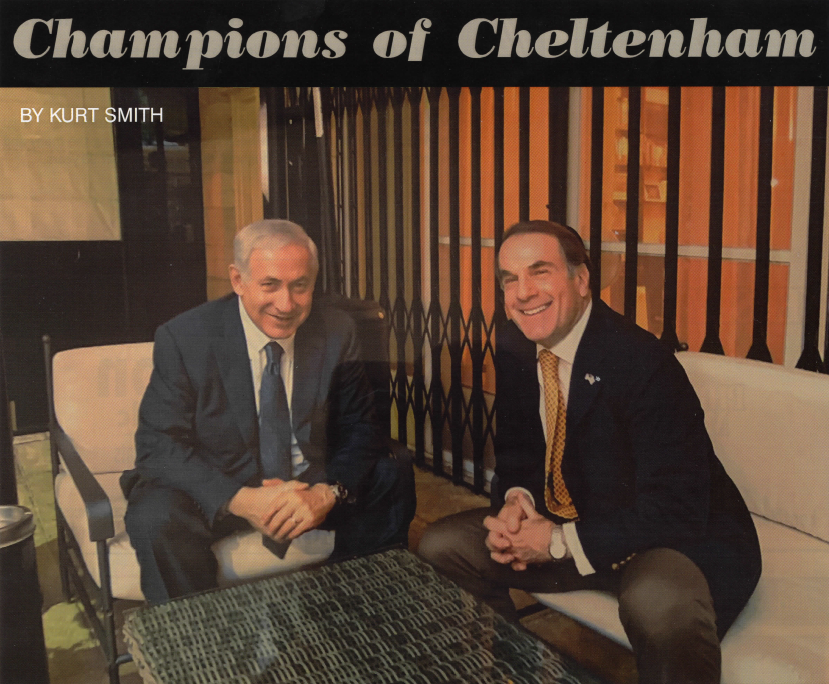
Champions of Cheltenham – Steve Friedman
Steve Friedman is a longtime success story as a Philadelphia attorney for the Duane Morris firm. He’s also a close personal friend of the Israeli Prime Minister and fellow Cheltenham High alumni Benjamin Netanyahu. The two share a common ability: to make a difference through people skills.
On August 13, 2020, the U.A.E. acknowledged normalized relations with the state of Israel. It was momentous enough to interrupt wall-to-wall pandemic coverage.
It was also the type of event that foreign policy “experts” were claiming for decades wasn’t possible.
But Philadelphia attorney Steve Friedman knows Benjamin Netanyahu well enough to know that Bibi didn’t rise to the top of the Israeli government by listening to bureaucrats, who often manage to attain “expert” status without ever actually achieving anything.
The two have been friends since attending Cheltenham High together. Friedman understands Netanyahu’s gift for the big picture.
“One of the great skill sets and amazing record of achievement of Prime Minister Netanyahu is in international relationships, especially in Africa,” Friedman explains. “He developed a relationship with Egypt and with Jordan. But to get a relationship with the U.A.E., it’s mind-boggling. It’s just incredible.
“There was nobody in the world who said, ‘the greatest threat to the world is Iran.’ I heard that from him in 1982. Nobody was talking about that; they weren’t talking about it 20 years ago.
“He’s always understood that, and what really has driven this tremendous change in relationship between Israel and these countries…it’s essentially a mutual fear of Iran. They began to realize, Israel is not the enemy. Netanyahu is not the enemy. It’s Iran, the Ayatollahs, and their very radical views for the way life should be lived.”
Steve Friedman currently practices for the prestigious Duane Morris firm. On the company’s website, he’s listed as being a “personal and legal advisor” to Netanyahu, which he admits is a bit pretentious. He didn’t write that.
“Let’s put it this way,” he says, “We’re very close. We just talk and he’s a very smart guy, so he talks to anybody. I think he uses me because of my involvement in some things in the U.S. He’s always interested in knowing what’s going on here, and to an extent, I can help him with that.”
Friedman remembers walking with Bibi from the U.N. to the Israeli ambassador’s apartment on 85th Street. Which, incidentally, is quite a hike.
“There would be these secret service guys and state department security, and he would walk like Mr. Magoo. He ignored traffic lights, just kept walking, and I could see these guys thinking, ‘God, just don’t get killed on my watch!’”
So while Friedman does, in so many words, advise Netanyahu on U.S.-Israeli relations, that probably isn’t the key selling point for hiring him.
More likely, you’d call on him to protect your company’s trade secrets.
He’s had a bit of experience doing so with high profile clients, including NutriSystem during their high-flying 1990s run. A weight loss company that enabled people to eat pancakes and still lose weight inspired quite a few copycats, including Heinz and Jenny Craig.
“Heinz owned Weight Watchers,” Friedman recalls. “It’s been years, but my best recollection is it was triggered by a relatively high ranking employee, who left NutriSystem and went to Weight Watchers. The next thing you know, we see them starting to do things that seem very similar to the unique procedures that NutriSystem had.”
A similar situation occurred with Sid and Jenny Craig, a case where Friedman successfully negotiated a large settlement.
“They originally had a relationship with NutriSystem, they then went to California, and waited for their non-compete to expire. They started a company in Australia, and then they came back to California and expanded. It was called Jenny Craig, and they started using what we thought were trade secrets to NutriSystem.
“Shea & Gould, the New York law firm, was on the other side. Very good lawyer. We went at it and pounded each other for a while and then settled the case.
“These cases start because somebody works for Company A, begins to understand the trade secrets, has a binding agreement not to disclose them, or under common law or the law of the state where they’re living, can’t disclose them anyway. Then they go to Company B, and then Company B is starting to do things that Company A did.”
Friedman has enjoyed substantial success convincing juries over the years, enough to earn multiple speaking engagements. One is titled “Selling Your Case to the Jury: How to Effectively Communicate the Technology Behind the Patent Dispute”.
“You have a story to tell, and it’s a narrative, and you hopefully have most of the facts that support it, and you have to convince the jury that your narrative is true and demands relief. It’s the essence of any good trial lawyer.”
Friedman achieved an even greater milestone representing Signature Financial Group against State Street Bank in a Federal Circuit appeals court. It was technology-based litigation in the late 1990s, as the Internet was beginning to flourish. Friedman estimates that the case had an audience approaching 500 people.
“I practiced arguments in front of panels of patent lawyers, to really pepper me with questions, to prepare me. When I walked in that courtroom, I just said, ‘we’re gonna win this.’”
The preparation turned out to be secondary in the win.
“The Chief Judge was a very senior guy in his 90s, Giles Rich,” Friedman reflects. “He had drafted the patent amendments in 1952. The opening question from Rich was, ‘Mr. Friedman, I see you’re not a patent lawyer, I find it interesting that you’re here.’
“I went on and on with some answer, and I said, ‘I know that you published the amendments to the patent laws of 1952, so I’m honored to be in your company.’
“It was just total bulls***! And he was so taken that everybody on my side said, ‘Oh my God, he had a twinkle in his eye!’ They said, that’s when you won the case.
“There was nothing dishonest, it was actually true, I was trying to play to his ego a little bit. Then about eight months later, we got the opinion and we won.”
How powerful is a personal rapport with a judge? Judge Rich’s ruling in the case was considered not only controversial, but contradicting of his own past decisions. That’s how much Rich liked Friedman. Rich’s Wikipedia page describes it thus:
“Judge Rich justified his conclusion on the basis that the business method exception to patentability was abolished by the 1952 Patent Act. However, this line of reasoning is contradicted by Judge Rich himself, among others. He had earlier stated, in a law review article written not long after the passage of the Patent Act, that Section 101 of the Act denied patent protection to business methods, observing that the diaper service, ‘one of the greatest inventions of our times,’ was patent-ineligible because it was a business method.”
To simplify all of that, maybe flattery really does get you everywhere in a courtroom. Including out on the lecture circuit, where Friedman spent several years as a result of the ruling.
Friedman has too many personal and professional stories to fit into the 1,300 words JerseyMan gives writers.
He may not have Netanyahu’s track record for public relations. Not many humans do. But like his Prime Minister friend, Friedman understands the value of storytelling and people skills, and the difference it can make.
During this interview, he even invited this writer to visit the memorial for Netanyahu’s brother with him. Yonatan Netanyahu was killed in Operation Entebbe in 1976; Friedman and Benjamin dedicated the memorial in 1982.
“Being a good trial lawyer…or being a good lawyer, period…about 98% of it is people skills, the ability to deal with people, understand people, and get them to work with you. And that’s true of life in general.
“It’s the heart of politics, it’s the heart of business, it’s the heart of everything.”
Hope you’ve enjoyed this article about a long respected attorney…
If you did, I would really appreciate your support.
When you use this link to shop on Amazon, you’ll help subsidize this great website…at no extra charge to you.
Thanks very much…come back soon!
The Hits That Made Me A Lawyer
Remember, as comedian Gary Gulman says, how football coaches used to refer to players incurring concussions from nasty hits: “He got his bell rung”?
As a high school and college football player…who shared a backfield at Cheltenham High with none other than “Mr. October” Reggie Jackson…Steve Friedman had his bell rung a few times. It ultimately ended his football career, which he thinks was probably a good thing.
“I had one concussion in high school, as a sophomore, I must have got hit in the head. I got up and I started walking down the field. They grabbed me and put me on the bench. I’m fully conscious, but I have no idea who I am, and then as the game is still going, I started to figure it out. That was the first one, and then the other two were sophomore year. Football was my life from the age of four until about 20, and then I was done.”
He learned in his freshman year at Yale that football has a way of talking you out of playing it.
“When I was a freshman, we would scrimmage against the varsity. The senior fullback was Chuck Mercein. You run at each other pretty hard, and I had pumped up to about 208, 210, Mercein was about 235, and running into him was like running into the edge of a steel building.
“Three years later, when I was a junior, I watched him in the first two Super Bowls, as a running back for the Green Bay Packers, and said to myself, boy, was I over my head!
He has no regrets. “I was always very proud of it, and the good news is, I had the brain concussions, presumably I can still talk and walk. Some friends joke with you, they say Steve, you were really stupid until you got those brain concussions, and you got a lot better!”
Photo credit: miss_rogue on Best Running
Photo credit: PFX Photo on Best Running
Photo credit: Official U.S. Navy Imagery on Best Running

E-ZPass: Tae Seangpeoam Interview

Tae Seangpeoam is the owner of Neztec Solutions, helping businesses’ communications meet regulations in a rapidly growing global economy. His street cred? He was a senior network engineer on the team that made E-ZPass work. JerseyMan sent me to interview Seangpeoam about the story. You can read the article on their website here, or view the magazine article here.
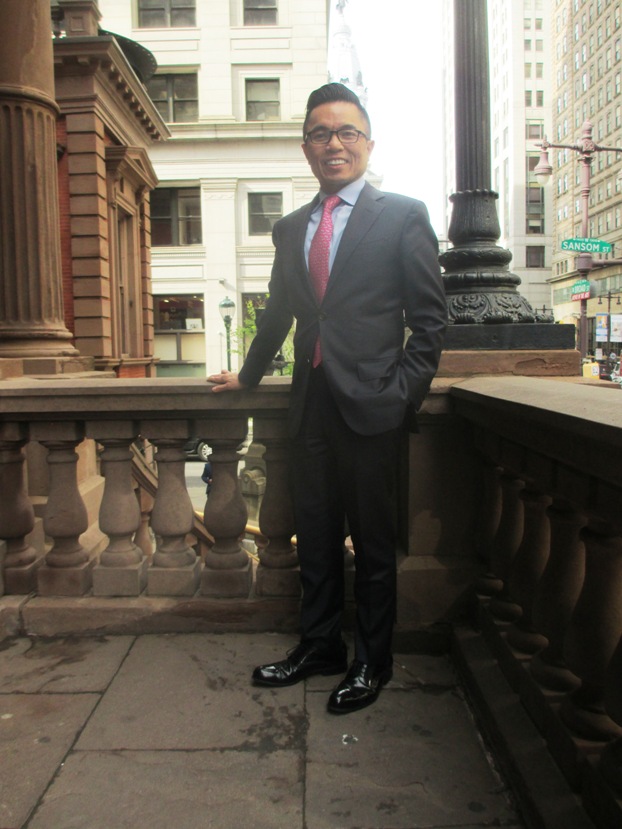
E-ZPass: Making Life EZ-er
When this writer’s young son first hears the “you kids don’t know how good you have it” speech from Dad, you can bet E-ZPass will be part of the conversation.
“Transponder? Heck, we didn’t even know what a ‘trans-pond-er’ was! Back in those days you dug into your pockets for that extra quarter ’cause the rates went up all the time, and you had to sit there waiting at the booth for hours, and then you had to hand your cash over to that guy who always dropped your change on the ground! Plus you had all those people asking directions while you’re waiting, like them toll takers are AAA or somethin’! You kids today ain’t got no idea what it’s like to be searching for a dime on the floor while you’re…look at me when I’m talking to you, son.”
Yes sir, those were the good old days.
Making the switch from stopping at booths and dropping exact change in baskets to using E-ZPass to fly through a toll plaza is one of those “why did I put up with that for so long” moments in life. That little white tablet stuck to your windshield opens up a whole new world.
Suddenly getting off of the Pennsylvania Turnpike temporarily for a break or a bite to eat is a more viable option, since you no longer have to dig out a few bucks and sit at a toll booth yet one more time. An empty pocket no longer stops you from using a toll road as an alternative to a jammed freeway. Tolls for E-ZPass users are less expensive in peak times, and now using the pay as you go road for the length of a long trip isn’t such an expensive idea.
Not to mention that little bit about how we don’t have to sit and wait at tollbooths anymore.
Tae Seangpeoam, founder of Neztec Solutions, is one of the people we can thank for the considerable road stress reduction from that little invention. Seangpeoam was a senior network engineer for MFS Technologies (bought out by MCI WorldCom that year) when the company was called on to improve a promising but fledgling electronic toll system.
As he sat on a sofa at the Philadelphia Union League where we conducted the interview, he clearly enjoyed the trip down a toll-free memory lane.
“I had just come out from college,” Seangpeoam remembers. “I was almost the youngest one on the team. I was so excited, they were saying it was going to be the project of a lifetime. When you’re young, to prove yourself, you do it. I was lucky.
“E-ZPass started in 1980, the idea. But it was never successful anywhere. There were many failures due to design, engineering, and government agencies. The project would never go anywhere because it kept collapsing between authorities. My responsibility, as a senior network engineer, was to design the architecture for the telecommunication; the communication between all of the toll booths going back to New York, to the violation process center, and to the customer service center.
“During that time the main problem was billing. Sometimes it would detect an axle, sometimes not, sometimes it wouldn’t detect your license plate. The camera was not clear, it couldn’t read clearly. The system didn’t know how to match that, and it would send a wrong bill or something. Back in those days, each toll booth didn’t have anything at all. It was just bare bones toll booths. Atlantic City Expressway, Garden State Parkway, they just had manual booths.
“We went in, took a look and surveyed everything, can feed a fiber optic line through that, or are we gonna do something else? We put satellites in several locations around Atlantic City. We did all that to link the communications back. All the transactions from the toll booth link back to the center to process, every transaction at the toll booth links back to the main frame. Also the security aspect…we had to make sure that the firewall and every single thing under the sensor is protected.”
“When we launched in Delaware, it was a tremendous success. All the toll booths were connecting to each other throughout New Jersey and Delaware, all the transactions were processed at the Violation Process Center and Customer Service Center, all the tags and transponder were communicating to the system, censor and lighting, backup video record, etc.
“The whole project was about three years; then I left the company and went to work for Verizon. I have a passion about communication; every single thing about it.”

It works so well we’ll use it in every lane.
So when you sail through the E-ZPass express lane, is there a camera taking a picture of your car and sending it to E-ZPass Mission Control to fire off the bill in the mail? Well, yes, that’s sort of what happens. But there is, of course, more to it than that.
As Seangpeoam explains, the transponder on your car connects with a sensor at the toll booth, and it sends a signal that the car with your ID is approaching. As your car is passing through, E-ZPass completes an entire profile on it…the type of car, how many axles, who owns the transponder, etc. Seangpeoam says it all has to jibe, especially the number of axles.
“If you look down the road at the toll booth, you’ll see the sensor of the treadle, to tell if your vehicle is a two-wheel, four-wheel, sixteen-wheel and so on. Those need to match to whatever the camera sees. The tag sends the signal that the car is coming, that’s what goes through the transponder. But it also sends a signal to another interface behind the scenes, to make sure that matches your transaction, because otherwise it could be a motorcycle or whatever.
Does that mean you really shouldn’t be using your transponder in your wife’s car? “You can use it in your wife’s car, but legally that’s a violation.”
This writer hasn’t yet tried that with his own tag, but Seangpeoam assures me that this contingency had been considered by the network people. “You’ll get the bill,” he says.
Today Seangpeoam runs the show at Neztec Solutions. His services, according to his business card, include real-time messaging, visual communications, and safety/compliance.
“In the past 10-15 years, you’ve started to see the global economy growing,” he explains, “And every single business has to deal with rules and regulations and compliance. That becomes really complex, and it is getting more and more complex. Even the small business has to deal with certain types of compliance and regulation.
“No matter what you do, no matter how good the things you come up with, communication is always the bottom line of the process. You’ve got A, you’ve got B, how are they going to communicate?”
Has the E-ZPass experience, especially persuading state governments to cooperate with each other, given him street smarts? “Absolutely. I wouldn’t be where I am now without that knowledge.”
He’s still today pleased with the results of the system he helped design. As he should be. Imagine I-295 today on Thanksgiving weekend, he says, how backed up the toll booths would be, say, at the Delaware Memorial Bridge. No thanks.
“I am really proud in what I have contributed to my adopted country. I was lucky enough to be part of wonderful projects; it gave me foresight to build a career around my life, and see the future of transportation, roadways, bridges and tunnels, and infrastructure communications.”
“Less time, less energy, less frustration, people are happier, more productivity for sure. You get to your destination faster, and with less stress.
I’m proud of that because again, the purpose of communications is to take society to the next level. If you want to make a phone call right now, you push the number and it’s gonna ring on the other side. The devil is in the details no one sees, everything on the surface is very simple, very easy, but that’s why an engineer like me loves it. I love to go behind the scenes and see what makes things happen without people knowing it.
“I’m a technology guy. I love technology. However, I don’t believe in technology that comes out and makes people learn how to use it. E-ZPass is the only technology in the past 15, 20 years or whatever, do you need to learn how to use it? No. You just slap it on the windshield and go. Even kids know how to use it, because it doesn’t require you to learn anything.
“That’s what technology is supposed to do.”
Hope you enjoyed this article about E-ZPass and its impact…
If you did, I would really appreciate your support.
When you use this link to shop on Amazon, you’ll help subsidize this great website…at no extra charge to you.
Thanks very much…come back soon!

Donovan McNabb – Forever A Leader
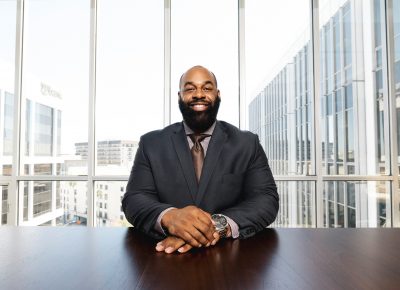
Donovan McNabb is one of the all-time great quarterbacks in NFL history, and will always be a local hero in Philadelphia. But today, he spends much of his time coaching athletes who are too young to remember his playing days. JerseyMan Magazine sent me to interview the Eagles QB for the Fall 2021 issue…you can view the magazine edition here.
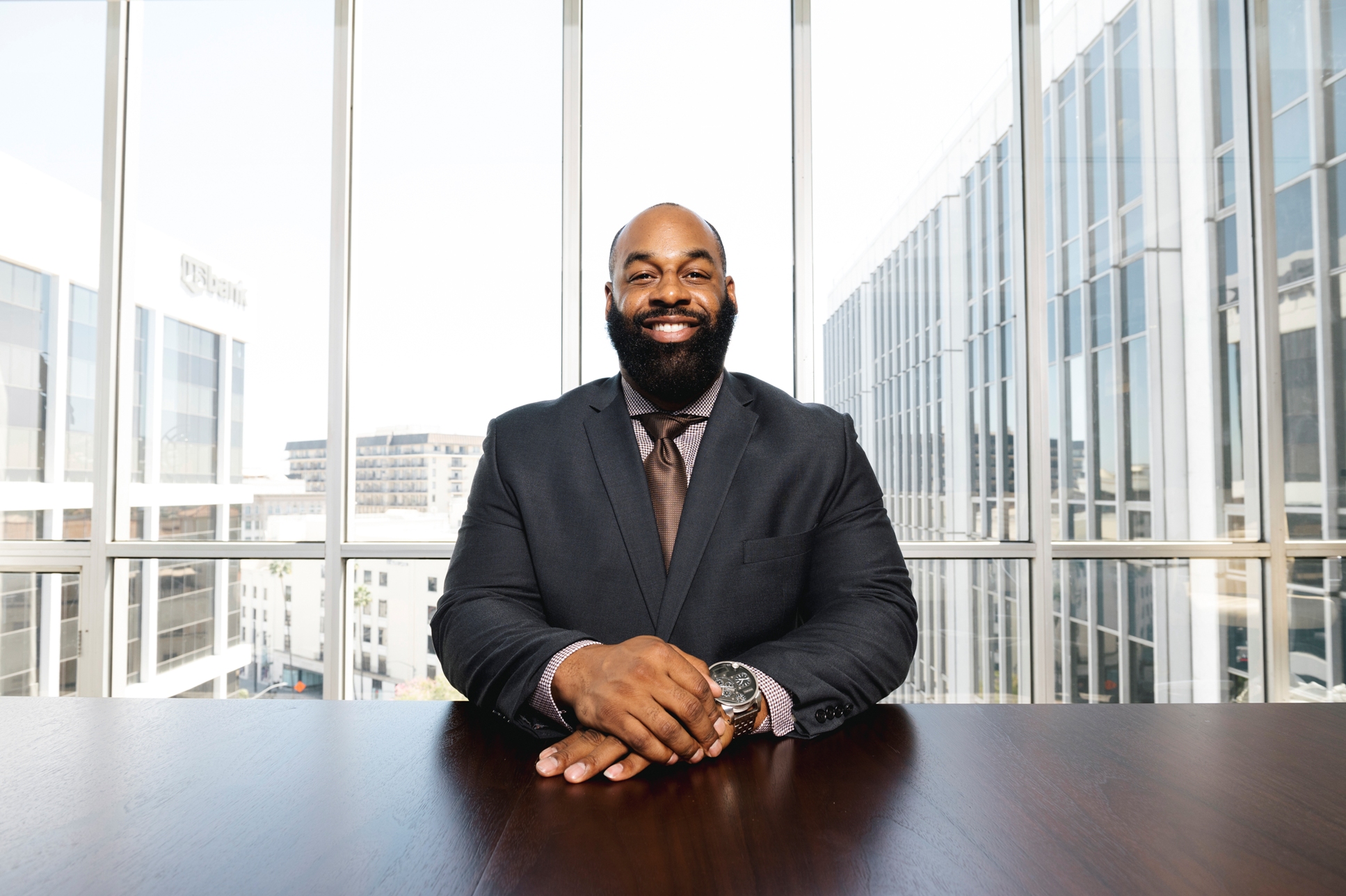
Donovan McNabb – Forever A Leader
Despite the opportunity to gather quotes and jump into a fray of controversy, JerseyMan didn’t ask Donovan McNabb about the most talked about events during his career in Philly.
We doubt our readers are interested in rehashing the decade-plus old rantings of a talented but ultimately cancerous ex-teammate…a receiver who was suspended and subsequently released by the Eagles for his statements, and then signed on with their most hated rival. No thanks.
But just in case you were wondering, no, McNabb didn’t upchuck in the huddle in the Super Bowl. There isn’t even discernible evidence that that happened, in an event that benefited from the best that television broadcasting had to offer.
As Mike Tanier’s Bleacher Report piece about the alleged incident puts it, “This urban legend is all about a quarterback’s inability to lead his team back from a double-digit deficit against one of the greatest dynasties in NFL history with four minutes to play in the fourth quarter.”
And no, the last player to wear #5 for the Philadelphia Eagles doesn’t hold anything resembling a grudge against local fans for their reaction to the team’s choosing him over Ricky Somebody in the draft.
It’s fairly easy to argue that the Eagles made the right call on that one. We love our friend Jaws at JerseyMan, of course, and the Eagles’ fan faithful will forever be grateful to Nick Foles. But by nearly any measure, McNabb remains the best quarterback to wear an Eagles uniform.
Put it this way. If you were a parent of a young quarterback, you wouldn’t object to having him as a mentor.
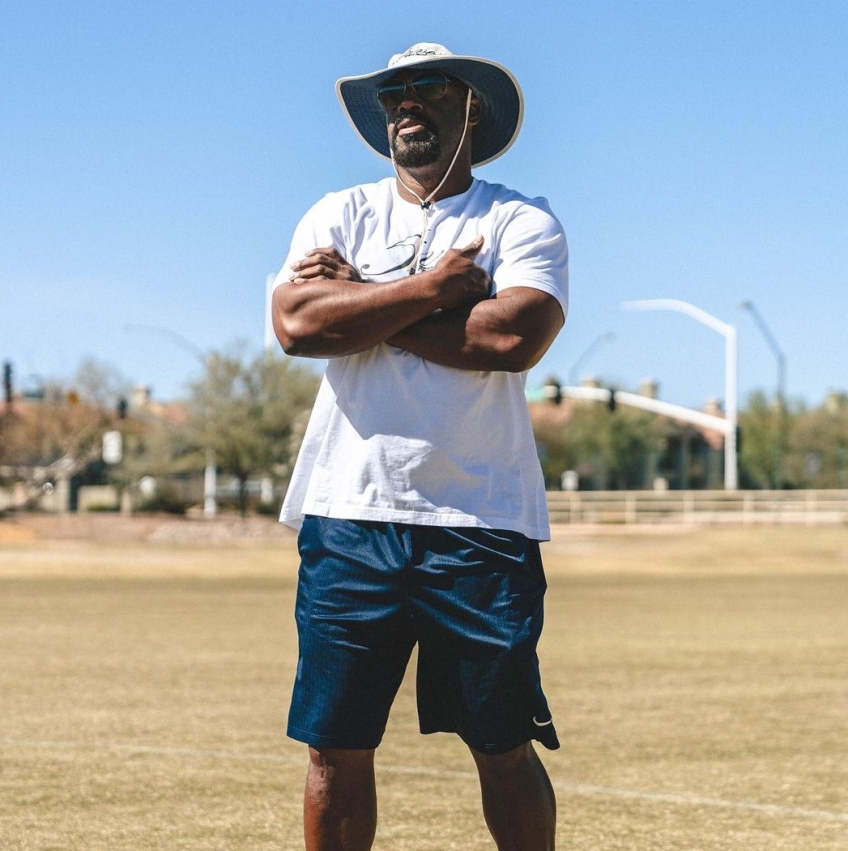
“Alright listen up…first thing you need to know, radio guys don’t know squat!”
(photo courtesy of Cathy Cardenas)
McNabb spends time today coaching young quarterbacks…junior high, high school, and college players. He is one of several former quarterbacks involved with The QB Legacy, a non-profit dedicated to teaching aspiring quarterbacks the fundamentals…not just of the game of football, but of being a leader in life.
Ty Thompson, a University of Oregon freshman, is one young quarterback who McNabb has mentored. As FanSided reports, Thompson is already a strong candidate for the starting job, and is Oregon’s top-ranked quarterback commit of all time.
“I’ve had an opportunity to implant my wisdom,” McNabb told JerseyMan, “on the things that they want to accomplish. I try to prepare them from a fundamental standpoint of knowing the intricate parts of the game. And also provide a little bit of spark for these young men, to give them that confidence that they can play this position at a high level, if they put the right time and effort into their craft.
“So many times you see trainers doing what they see Patrick Mahomes do or what they see Aaron Rodgers do. And I think that’s a negative, because not everybody is on their skill level, not a lot of people can do what they’re doing at this particular point.”
Most of the young players McNabb coaches don’t remember his playing career. But their parents do.
“The last time I took a snap was nine, ten years ago, and that was in Minnesota toward the end of my career. A lot of these kids have never seen me play. It’s more the parents that know a lot about you.
“And I have no problem with that, because I’m not coming in there, Donovan McNabb, NFL quarterback, I’m coming in as Donovan McNabb, quarterback trainer, that’s going to help you be able to perform at a high level and prepare you from a mental and physical standpoint.
“I’ll show up at their games and write down some different things that we can do on our next couple sessions. I’ll be there when they need any assistance, maybe something happened at practice and they don’t understand why, how they can change it or things of that nature.
“If I have a kid that’s in middle school, I want him, by the time he graduates from eighth grade, to be mentally where the sophomores are in high school. We know your body’s going to develop at some point. But from a mental standpoint, can you be able to get out on the field and tell each and every player what they’re supposed to do, explain to the coach what you’re seeing from a defensive standpoint, what blitzes they’re doing, how to attack those blitzes.
“That right there gives you the upper hand when it comes to a lot of these kids who are just athletic, because now there’s a trust value that coaches are starting to build with you, because they know you’re well prepared and understand the games.”
And yes, you have to handle shots from critics. As we all remember, McNabb knows that better than anyone.
“It’s not just younger kids,” he continues, “it’s adults too, who have issues with criticism. With social media now, people don’t like something that you post, or people comment negative to you, it affects them, instead of just moving on and using that as motivation.”
So is he tempted to tell young QBs not to play in Philly if they can’t take the heat?
“It’s not so much that, Philadelphia is kind of well known for that. But again, you’ve got to stand strong and you’ve got to be able to take it, move on.
“Smile, that’s what I did!” McNabb says with a laugh.

If you want to learn how to play high level football, ask someone who’s played high level football.
(photo courtesy of Cathy Cardenas)
As a lot of JerseyMan articles about retired athletes have shown, success on the field doesn’t necessarily translate to success in other walks of life, but it definitely helps. Part of the goal of The QB Legacy program is preparing young athletes for life outside of or after football.
“The most important thing for me,” McNabb explains, “is trying to get these young men to understand that being the quarterback of a Division I program or being a quarterback of an NFL organization, that you are the CEO. You are in a boardroom in front of millions or thousands of people. Can we put you in front of a room, and you explain to me what each and every person is supposed to do in this office?”
“We’re building leaders, we’re building mentors, we’re building role models. We’re building CEOs. We’re building guys to understand that it’s much more than just playing the quarterback position. You have ten people on the field with you that are relying on you to make the right decisions, to lead them to a Super Bowl.
“And so you have to do your job. You have to be able to prepare yourself to go out and be at the highest level of your craft.”
Whether it’s young quarterbacks, or softball or girls basketball players, whom he also coaches, McNabb today is preparing the adults of tomorrow for the game of life.
As with many of the good guys in sports, it’s the preferred way of enjoying retirement.

If I just offered to buy his cheesesteak, I could be shooting pool with him.
(photo courtesy of Cathy Cardenas)
This scribe choked on his chance to meet Donovan McNabb.
We don’t have much in common as far as athletic achievement or income level, but we’ve both been known to frequent Gaetano’s in Willingboro. And yes, we’ve been there at the same time. My hang-up about approaching celebrities during meals overrode taking advantage of a rare opportunity to chat with an NFL superstar.
McNabb lives in Arizona now, mostly just because the weather is better. It was where he started training in the second year of his career, and he liked the area enough to stay.
“It’s a great vacation place,” he says. “My family was from Chicago, friends in Philadelphia, New Jersey, when they come out here, drop the winter coats and Timberland boots, put on some shorts and a tee shirt and just relax.”
But he’s got nothing against the city where he made his considerable mark. Donovan still visits and loves Philadelphia and South Jersey…and mentions Gaetano’s as one of his favorite eateries in the area.
“I’ve still got friends there, I love the area. I’m talking over 15 years, pretty much, since I’ve been in Philly, but I go back and it’s like I still live out there. The people that know me are the people that watched me play, still remember you, have conversations with you.”
He’s happy for both the Eagles and Andy Reid for their Super Bowl triumphs. Regarding his former coach, McNabb believes that the Super Bowl win “implants him when it comes to one of the greatest coaches. For the things that he’s been able to accomplish over the years with us, and then turning the Chiefs organization around. Andy definitely is a sure shot Hall of Famer, and winning that Super Bowl is definitely going to help.”
They fell just short as a pair themselves. But McNabb hopes people remember the good times, with Andy at the helm and with #5 as the field general.
“I would love to have won a Super Bowl,” he reflects, “but that doesn’t define who I am as a player or who I am as a person.”
Maybe someday Ty Thompson, or another McNabb pupil, will get that done for him.
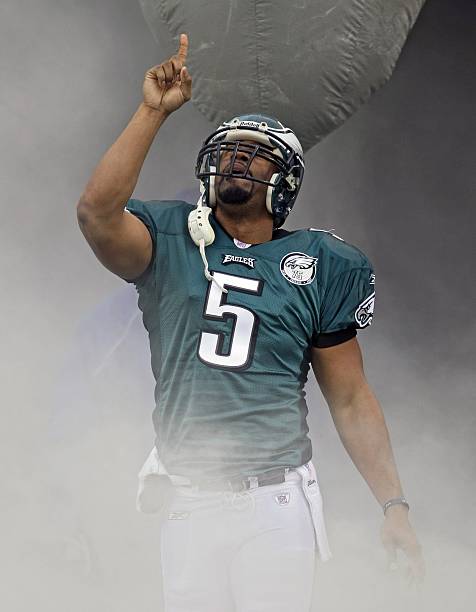
If they take pictures of you surrounded by dry ice, you probably belong in the NFL Hall.
(photo courtesy of Cathy Cardenas)
The Case For McNabb In The Hall
Wait, what? Donovan McNabb, the greatest all-time quarterback on a team that had Roman Gabriel, Ron Jaworski, and Randall Cunningham, isn’t in the NFL Hall of Fame?
Nope, he’s not. Critics say something to the effect of his not having won a Super Bowl, despite coming within three points of doing so against the NFL’s greatest dynasty, or not being a leader in statistics during his prime years, with no mention of the subpar receivers he had to throw to at the time.
So at best, McNabb’s entry into Canton is being denied by his crime of having less than championship level teammates.
He doesn’t go there, though.
“There’s no need for me to make a case. I think numbers and film alone define that. Some people look at numbers, some people look at accolades, some people look at Super Bowl championships, some people look at appearances. And so you can’t please everybody. So for me to try to state my case, no, it’s nothing to it.”
“Look at Walter Payton, people always said that Walter had to win a Super Bowl. Walter Payton was the best running back to play the game at that particular time. He also was one of the best players to ever play the game, not just running backs.”
“So, when it comes to a lot of these players, it’s sad that we want to sit and talk about, well, how many Super Bowl championships have they won, or how many times they’ve been All-Pro? How about, why don’t you ask the defenders they played against, ask them how hard it was, the game plan against them. It says a lot.”
So do McNabb’s numbers…37,276 passing yards, 3,459 rushing yards, and 234 touchdowns. Six Pro Bowl appearances, five NFC East championships, five NFC Championship game appearances, and nine postseason wins. If you find any QB with similar numbers, they’re probably enshrined in Canton.
From 2000-2004, McNabb led the NFL in QB wins. During his career, he ranked fourth in wins behind guys named Brady, Favre, and Manning.
There’s always arguments with every Hall of Fame induction about who got slighted. Donovan McNabb shouldn’t be the subject of one.
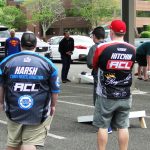
Professional Cornhole – Beyond The Parking Lot
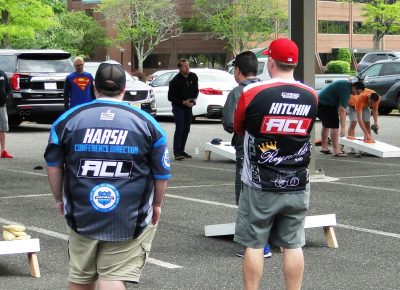
JerseyMan asked me to cover a local cornhole event they arranged, and to work in a piece about the phenomenal growth of professional cornhole in the midst of the COVID-19 pandemic. Hope you enjoy it. You can also view the PDF of the article here.

Professional Cornhole guys.
Beyond The Parking Lot – Professional Cornhole
You can write for JerseyMan and attend Legacy Club events for ten years, and almost never see Ken Dunek animated enough to shout loudly and pump his fist.
Then again, you don’t see many people gain a lead against John Kitchin in a cornhole match, however short-lived that lead may be until Kitchin finds his bearings and starts effortlessly nailing throws. It’s understandable for even a reserved person to be thrilled at the achievement.
This anomaly was at the Infinity Club Cornhole Tournament, held this May at the PCS facility in Moorestown. The event raised nearly $4,000 for the Leukemia & Lymphoma Society, and for survivor T.J. Smink’s bid for the Society’s Man or Woman of The Year.
Of course, many esteemed Legacy Club members were present. It’s an ideal opportunity to avenge a recent defeat on the golf course. No one tanks, of course, but a loss isn’t so bad…it’s an opportunity to grab a drink and catch up with fellow members.
One would think that, in a crowd of Eagles fans, who have to have considerable tailgating experience, there would be some players standing out in the crowd. But other than Smink’s team, who prevailed in the match, most of them were unexceptional shooters. Even by frequent tailgater standards.
The tournament was for fun and to help less fortunate people. PCS’s parking lot is obviously no billion dollar, luxury box-filled venue.
But professional cornhole has grown well beyond the parking lot.

Apparently, everyone else forgot their uniforms.
Present at the gathering were Kitchin, a national cornhole pro who resides in West Deptford, and Joe Harsh, the American Cornhole League’s (ACL) Northeast Conference Director.
Yes, there is a nationwide professional cornhole league. As seen on TV.
Before 2020, the ACL had already landed some national television deals, and events could be seen on various sports networks. Then they got a boost…professional cornhole became one of the rare entities that benefited from an outbreak. With no baseball, football, basketball, hockey, etc., there was a fairly ginormous hole in sports broadcasting to fill.
So cornhole moved into seriously choice TV slots. Harsh notes that “We had eight to ten broadcasts on Saturdays, prime time with our Pro Division, and traveled all over the country.
“We’re really fortunate,” he adds. “Everything went well for us. And the exposure and the growth, it’s been really, really beneficial to the league.
“I’ve known John for a couple years now, and the fact that someone would ask John for an autograph, it’s the coolest thing.”
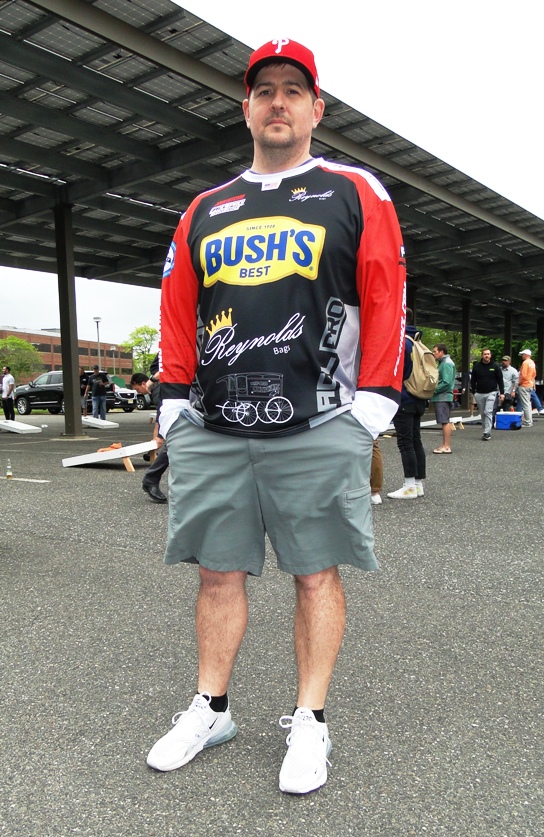
John Kitchin, who is probably better at cornhole than you.
Kitchin has been known to drive to Cincinnati for the day to throw bags. At least, that became a thing for him when someone noticed he was a pretty good shot at tailgates.
“I played in the parking lot of Eagles and Phillies games, and a guy came to me and said, ‘Hey, we have a league for this.’ I kind of laughed at him. Here I am seven years later, and if I could play more I would.”
Indeed, Kitchin started playing in a league, and did well enough to compete in local tournaments. Then he became a pro. Then an ACL Pro.
He’s added some impressive achievements to his league bio…#1 Northeast Conference player in 2018, ACL Man of The Year in 2019, and a 2nd place finish in the 2020 USA Cornhole Club Championships – broadcast on NBC Sports – to name just a few. He’s so good that Bush’s Baked Beans and LG have put their logos on his jersey.
You can see why even Ken Dunek would celebrate well beyond his typical demeanor scoring a lead against him. Which, to Kitchin and Harsh, is part of the appeal…anyone can play, even against the pros.
“I play in leagues around here all the time,” Kitchin says. “I play pretty well, but there’s a lot of people who, when they play against me, they use that as a measuring stick. I don’t beat everybody, so I think that makes them even more interested…‘That guy’s been on TV!’”
“That’s the coolest part,” Harsh adds. “You can see him on TV on the weekend, and then Monday or Tuesday night you could literally play against him.”

Professional Cornhole announcer Jeff McCarragher, offering his well thought out insight about a match.
(photo courtesy of Jeff McCarragher)
Jeff McCarragher is a freelance sports broadcaster. His LinkedIn profile describes his most recent position as a “Play-by-Play Announcer for College Football & Basketball…and yes, Cornhole too.” His resume covering other sports is impressive, but by most any measure, McCarragher is the Voice of American Cornhole.
He landed the gig by simply being in the right place at the right time. Literally.
A South Carolina resident, he worked college football and basketball throughout the Carolinas. Tupelo Raycom, the company that brought him announcing work, had an office there. And they knew ESPN needed a cornhole announcer.
“When COVID hit, being a freelance play-by-play broadcaster was like being a waiter or server at a restaurant,” he remembers. “We were shut down immediately because all the sports just went away. When they got the contract on ESPN, they called me and said, ‘Hey, are you willing to travel if we put together cornhole through the summer?’
“I had done a little bit for them in the past, I’d done the national college cornhole championships that previous New Year’s. I said, absolutely, I’m comfortable traveling. And so away we went, ESPN signed a deal with the American Cornhole League.”
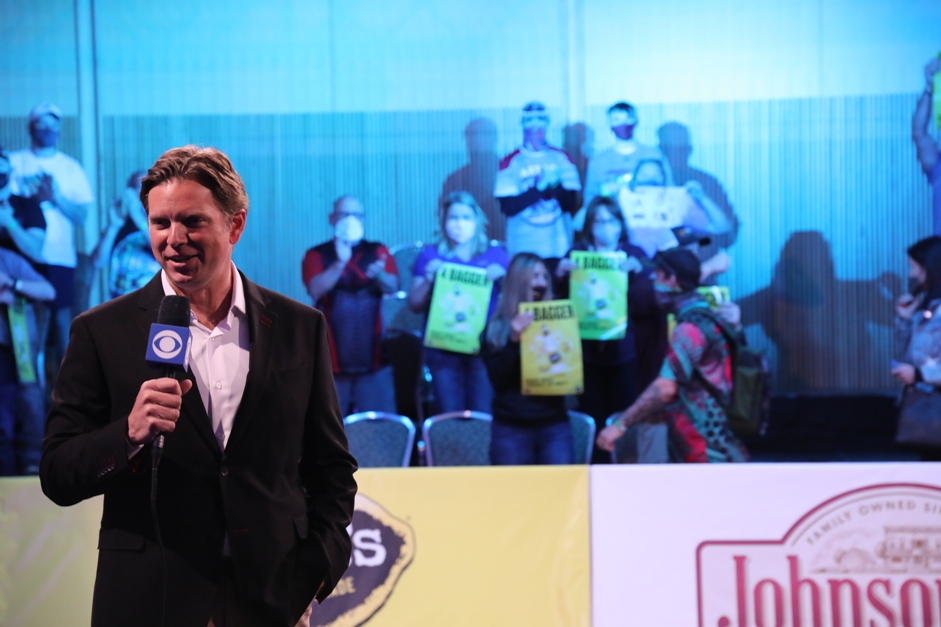
No, those aren’t protestors. They’re cornhole fans.
(photo courtesy of Jeff McCarragher)
McCarragher’s enthusiasm for covering professional cornhole of all things is palpable. The players may not have toiled through college or minor leagues, but they definitely have well-developed skills.
“It’s a very simple sport, right? You just slide it up the board and put it in the hole. But just like any other sport, when you get to a very high level, you start to learn how technical it is. I had to learn a whole new vernacular, whether it’s replacement bags or grab bags, the way a player collects the bag.
“I relate it to being a really good major league pitcher. He’s got his fastball, his slider, his cutter, his change-up. The ones who play at the top level, they’ve got a little cut shot, they’ve got an airmail shot. They can make the bag curve one way or another, they can angle it and get the bag to kind of roll. Instead of different pitches, they have different technical shots that they can throw. It’s really pretty amazing.”
There’s considerable tension in big matches, too.
“It gets to be like golf,” he continues. “You’ve got a two-stroke lead, or maybe a one stroke lead, going into the 72nd hole on Sunday. I don’t care who you are. That final tee shot on the 18th? It has to be good. There’s so much pressure. Again, I get it, it’s cornhole. We’re not talking about the Masters. But it’s still competitive, the desire to win for these players.”

Aspiring cornhole pros at the Legacy Club event.
McCarragher is confident that the growth of professional cornhole will continue, even with the return of other spectator sports.
“Did COVID help give it added exposure? Absolutely. But I will tell you, they have been working behind the scenes with these little ESPN contracts now for several years. They were on ESPN a few times in 2018-2019. We had college national championships on New Year’s Eve going into 2020. The ratings were slowly going up and up. So this was already on the rise.
“Just by the sheer TV contracts that are coming in and new sponsors, I for sure would say that the ACL is still growing.”
Kitchin agrees.
“I think the success they had during COVID is going to allow them to continue. Will the viewership be the same? Perhaps not, but I think in this country there’s a niche for these types. Like, would you watch baseball, which is hours long, or you’re clicking through and, ‘Oh, cornhole, this is something I do in my backyard. My buddies and me bust our chops all the time, let me watch this. I think that’s what’s opened it up for those types of things.”
Joe Harsh has already experienced professional cornhole’s impact beyond TV.
“For me it’s not even the size of the events and the cool venues we’ve visited. It’s some of the charity work we’ve done, like for veterans groups. We did an interview with a guy, roadside bomb in Afghanistan. Long story short, he’s a double amputee, and he’s thanking me for everything I do, and it just absolutely blows my mind.
“I would do anything for someone like that because they’ve given so much, and they’re thanking us for what we do and the release that we give them. That’s my favorite thing to take away from all of this.”
Needless to say, McCarragher is eager to keep telling the story.
“I would love that guys would call and have me do a national college football championship. As young broadcasters coming up, we all hope to get that call. But even that being said, I still really would always hope I can continue doing cornhole.
“I will do this for as long as they’ll let me, because I love it.”
Hope you enjoyed this article about Professional Cornhole…
If you did, I would really appreciate your support.
When you use this link to shop on Amazon, you’ll help subsidize this great website…at no extra charge to you.
Thanks very much…come back soon!
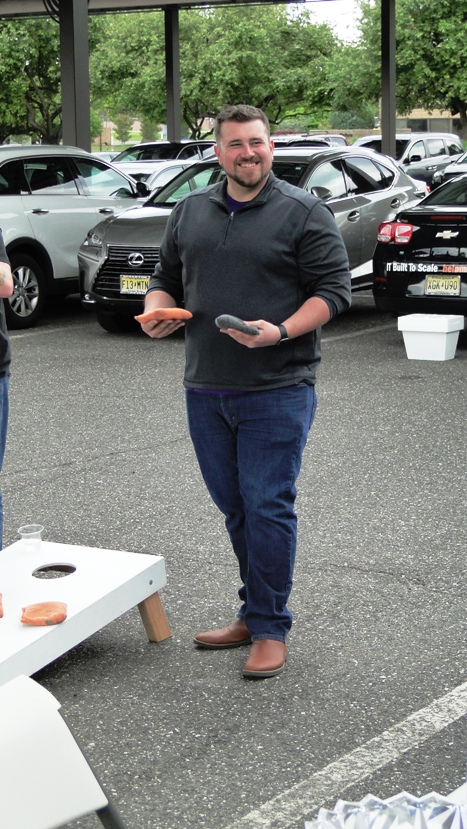
T.J. Smink, defeater of cancer and local cornhole legend.
Smink Strong
T.J. Smink, who won the Infinity Club Cornhole Event with his partner Kyle Reider, had personal reasons for both winning and co-arranging of the event: he is a cancer survivor himself.
Smink is a Senior Account Executive for Premium Seating with the Philadelphia Union. But in 2020, the shutdown of sports was the least of his worries. In December of 2019, he was diagnosed with stage four Hodgkin’s lymphoma.
He decided to control two things that he could control: his hair and his attitude. He shaved off the hair he felt he was going to lose from treatments…but ultimately didn’t. And he kept upbeat, all the time.
“I made sure to keep a positive attitude, to look on the bright side of life. Having that mindset, being able to say I’m going to beat this s***, that was way more than half the battle.”
Legacy Club member Devin DiNofa, at the time campaigning to be the Leukemia & Lymphoma Society’s Man or Woman of The Year, reached out to Smink.
“He’s an awesome dude,” Smink says. “He asked if I would be on his team to help raise money for others. Even then, he wanted to work with LLS to raise funds for me directly, LLS said we can’t go towards one specific person.
“Even then, I went back and told him, I’m killing this s***. We’re good, I appreciate it, but I would prefer it goes to someone who actually needs the funding.”
Today Smink, at DiNofa’s urging, is campaigning for the LLS Man or Woman of The Year himself. The Infinity Club Cornhole event was a part of that, to great success.
“Ash (Ashley Dunek) came up with the idea of working one of the Infinity Club events into a fundraiser. And we had a really big turnout. There were 32 teams and a lot of people that came just to hang out.
“Our team is going to get a research portfolio named after us. I’m excited to see where that research goes.”
And he and Kyle Reider topped it all with a cornhole tournament win.
“He’s a lot better than I am,” Smink says of his teammate, “but together, we normally win all of our friends’ get togethers and stuff.”
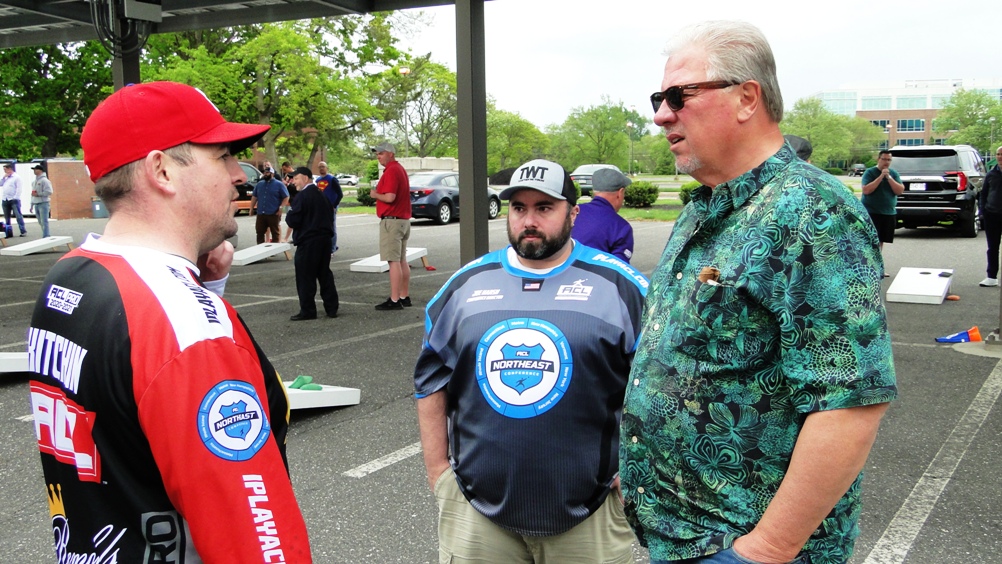
Ken Dunek, feeling relieved at the end of his match with John Kitchin, asks Kitchin for cornhole tips.
So You Want To Be A Professional Cornhole Player?
In a write-up about John Kitchin from Power Equipment Direct’s website, he is described as a professional cornhole player who “practices for roughly 32 hours per week, where he throws 2,000 to 3,000 bags.”
While that is probably technically true, Kitchin doesn’t exactly work in his garage, perfecting his follow through and stance and watching himself on video. He just plays a lot, which to him is the simple secret to improvement.
“When you figure in going to leagues and playing tournaments on the weekends, and then throwing it in my shop or something like that, the amount probably adds up. I play on the leagues on Tuesday nights and Wednesday nights, and Thursday nights usually where I try to get out too.
“If you want to become a better cornhole player,” Kitchin continues, “just get out and play, go find a local league. Even if it doubles as a night out, you know, go out and play. You’ve just got to get throws in, and if you can’t and you just throw in the backyard, go out and throw. You have to throw bags.
“So practice for a pro to me would be going out and playing in your own league and it’s all about getting throws in.”
Wait, no proper ways of holding the bag? No commentary on wrist movement? Nothing about how to warm up? Kitchin says that once you find a groove that works for you, the mental aspect is far more important. And that part can’t always be taught.
“I’m probably the worst pro to talk about this, because I’m a firm believer of under-thinking. People overthink. It’s whatever is most comfortable to you, you just have to tweak that. Throw eight bags, and I would want to see how you threw. And I would say, was that comfortable? If that’s comfortable for you, you can tweak it from there.”
That sounds simplistic, but he’s right. Cornhole players lose matches overthinking.
“I might throw 50 bags in a row in the hole, but what changes from the time that you just threw 50 bags in a row and then you line up next to me? What just changed? Nothing changed except for your mental, so you’re overthinking it. Now all of a sudden that same guy who’s just hit 50 bags in a row off to the side warming up, is now maybe two on two in. It’s the overthinking.”
“I try not to worry about all that.”

Cornhole for a cause.
Why We Cheer – The Human Interest Stories
The ACL is fortunate to have Jeff McCarragher behind the microphone, because he does what the best broadcasters do…he tells backstories about the participants.
He shared a small few everyman stories of cornhole stars with JerseyMan.
“Steven Bernacet, he won the singles national that we just had in Wichita about a month ago. Outstanding cornhole pro, but in his senior year, he was a great high school football player, lineman. He was in a horrific car accident and broke his neck. He could have died.
“The doctors immediately told him he wouldn’t play contact sports ever again, obviously to a high school kid who’s played sports his whole life, it’s devastating to him and his family. Two years later, once he was able to rehab and get back to his new normal of life, he picked up cornhole, and has been playing cornhole ever since now.
“It’s been his outlet and his happiness and his source of competitiveness, to fill that desire and that need in his life. Cornhole has been literally life changing for him.
“One of the top female pros is a manager at a Taco Bell. You know, she plays cornhole on the side. Daymon Dennis, who’s the number one player in the world right now, worked at a cheese plant for 27 years.
“He used it to support his family and to keep food on the table. And now here he is, number one player in the world.”
“It’s like American Idol,” McCarragher says. “There’s a lot of people who can sing, but what captured the audience and the ratings for American Idol is all the backstories.”

The Resilient Reading Terminal Market

The Reading Terminal Market in Philadelphia had its struggles in 2020, so JerseyMan and I gave it some well-deserved props for the January 2021 issue. You can see it on JerseyMan’s website here, or see the magazine article here.

The Resilient Terminal Market
The Reading Terminal Market was hit hard by the pandemic, losing over half its foot traffic throughout the tourist season in 2020. The merchants, locals, and even some outsiders came together to help keep the lights on, but the quality of the goods is ultimately what keeps the Market going.
A visit to the Reading Terminal Market is well worth any travel expense and hassle, but it always presents an exasperating conundrum:
“What the hell am I gonna eat?”
Human stomachs are insufficiently sized enough that in every trip to Philly’s venerable marketplace, it’s impossible not to miss out on something amazing. It’s particularly rough for tourists, who may only manage one or two visits.
The Market sometimes seems to cause more culinary heartache than pleasure. Sure, have one or three of Beiler’s doughnuts…but unless you have a committed sweet tooth, that means foregoing Dutch Eating Place apple dumplings, Flying Monkey whoopie pies, or Termini Bros. torrones.
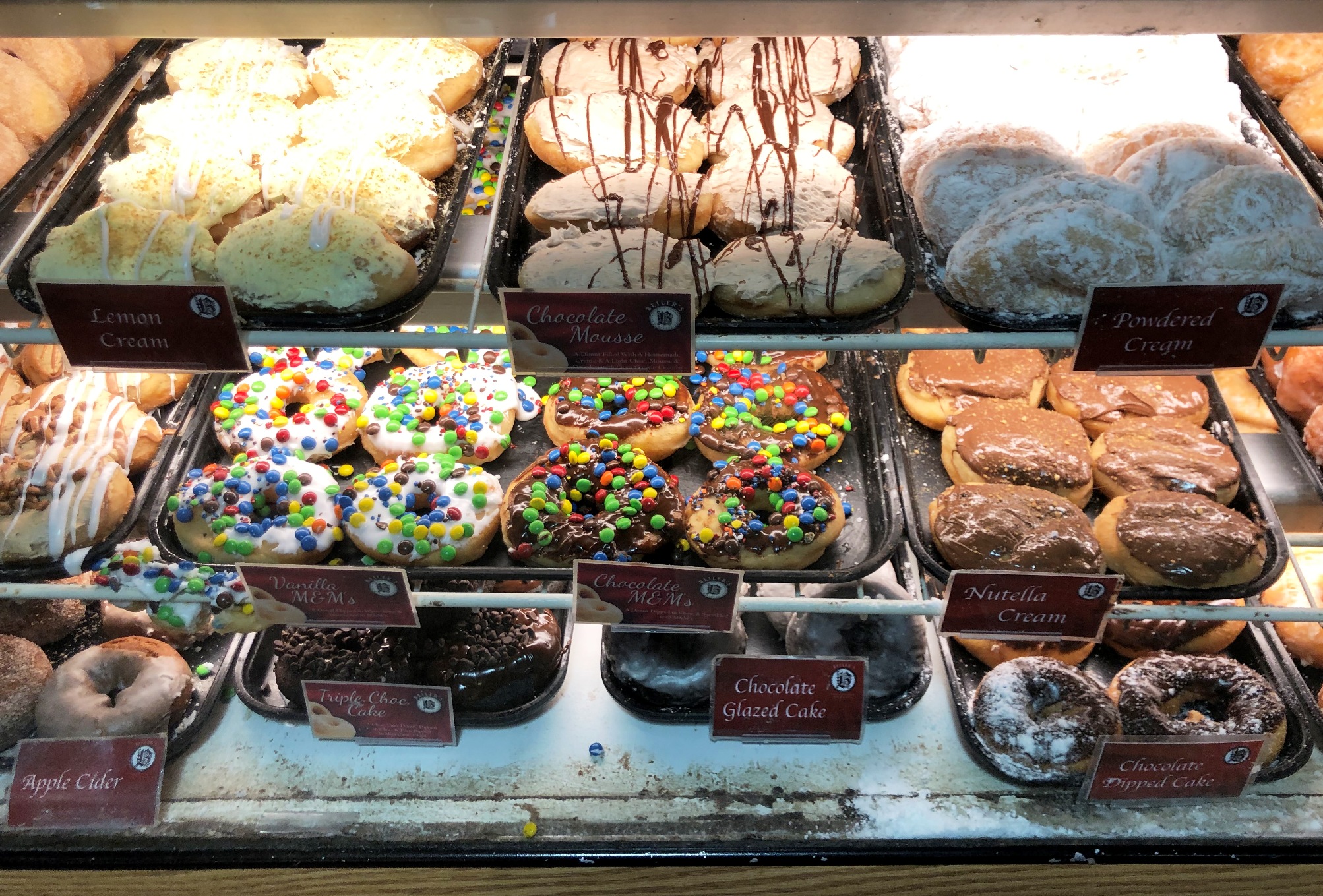
Sorry, what were those other choices again?
If you’ve ever experienced this distress, you’re not alone.
You’d think the Market’s general manager would have sound advice for this situation, but unfortunately Conor Murphy isn’t much help. Murphy visits the Market every day, and even he struggles mightily with the question.
“There’s just so many great sandwich options,” he says. “You’ve got a fantastic sandwich at Smucker’s, DiNic’s is obviously incredible. I’m an unapologetic carnivore, but there’s great sandwiches too at Luhv Vegan. Whether you want a chicken sandwich or a beef sandwich or a fresh deli sandwich…Hatville Deli does a great job…there’s just too many choices almost.
“It can be a challenge sometimes to choose your lunch. Phenomenal options, the classic Philadelphia specials, and also obviously great healthy options too.”
London Faust is the digital media manager at Bellevue Communications, the firm that manages the Market’s PR. She is a bit more willing to risk choosing a go-to vendor; she recommends Olympia Gyro.
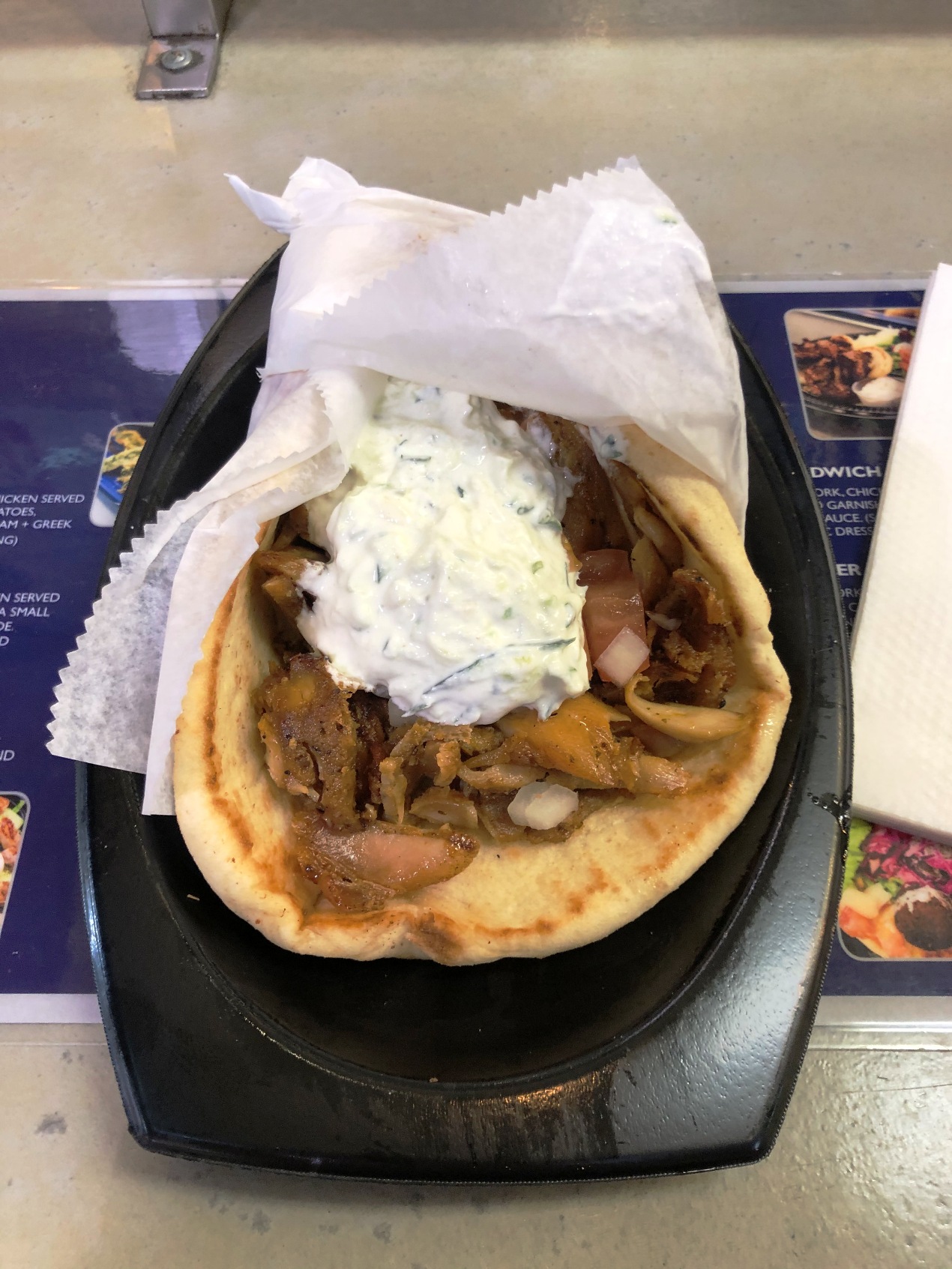
Just for the record, she’s right.
“It’s well balanced and a good bang for your buck,” she shares. “Their gyros are really good and fresh, and don’t fill you up to the point where you’re so uncomfortably full, but they also have the biggest, freshest salads I’ve ever seen.”
Okay, that helps a bit. Murphy also offers a small but valuable piece of advice: Don’t look over your shoulder.
“Sometimes if you’re standing at DiNic’s, and then you look over your shoulder and you see Hershel’s, well then suddenly the decision just became much harder. You go to Olympia where London likes to go, and you turn over your shoulder and there’s Kamal’s.
“You kind of have to come in with your blinkers on almost. Make your decision and get it done. Because if you turn your shoulder, you might have to change your mind.”
This extreme gastronomic agitation is the true appeal of the Reading Terminal Market. For locals, the substantial selection of food staples keeps one returning, again and again. For frustrated tourists, it may inspire a better-planned return visit to Philadelphia. The Market is equal parts tourist attraction and favorite local destination, and it does both very, very well.
That balance has been key to its survival in the toughest of times. Which 2020 unquestionably was.

We will get through this, for the Market’s sake.
(photo courtesy of the Reading Terminal Market)
Throughout the history of the Reading Terminal Market, it seems to have been positioned to survive world instability. That doesn’t just include a depression and two world wars. The Market has weathered other storms too, like the decline of the railroad industry.
The “Reading Terminal” part of the name comes from its location, as a key hub for the Reading Railroad. The rise of the automobile drove the Railroad into bankruptcy by 1971. The Reading Company remained overseeing the Market, but they instituted higher rents for already struggling merchants, driving many of them away.
Decline and crumbling infrastructure continued until the Convention Center Authority purchased the Market in 1990. With that deal came $30 million of public funding for upgrades. To secure that kind of cash, you’ve probably got some clout with the locals.
So where does a worldwide pandemic rank among the tribulations the Market’s endured in its 128 years?
It’s probably top three.

People never stay away from Bassett’s because of the quality of the ice cream.
“The Market has been through a lot,” Murphy says. “But I’m looking back through history, talking to different merchants and historians, and there’s a general sense that this is certainly up there with those past experiences.
“Usually from April through Thanksgiving, food and beverage options around the city get a lot of foot traffic. On a Friday or Saturday the Market would have anything from 35-40,000 people a day coming through. This year, it was anything from 55-60% drop in those numbers.”
The difficulty of social distancing in a tight city venue doesn’t help. “As an old train station, you can imagine the building is equipped for lots of people coming through,” Murphy adds.
Like every establishment in the country, the merchants have had to adapt to survive. But just as every difficult period in our history has revealed the strength of the Market, the challenging times caused folks to rally behind Philadelphia’s favorite food destination.
Even from as far as Boston.
As efforts grew to help the Market stay operational, including adding a GoFundMe page, it attracted the attention of Dave Portnoy, founder of Barstool Sports. Despite being a Beantown area native, Portnoy is a Philly food enthusiast and passionate about supporting the cause. He arranged for Penn National, the owner of Barstool Sports, to donate $100 for every $100 deposit made by fans in the Barstool Sportsbook app.
It was a significant factor in the GoFundMe campaign’s success, which has totaled $211,597 as this sentence was written, contributed by 4,773 Market fans. The funds will be enormously helpful for day-to-day operations.
“Since the beginning of the pandemic,” Murphy explains, “we’ve offered support to merchants in the form of rent deferments. One of the other things that we do a lot is events, and we are able to cover a lot of our costs through some of those events. So without the events, and with some deferments in place for merchants, we wanted to make sure we were able to remain available and open seven days a week.
“Simple things, being able to pay utility bills, and all the extra sanitation costs that we now have to keep customers safe.”

Keep the lights on for Hershel’s sandwiches.
Murphy is overwhelmingly appreciative at the reminder of how beloved the Market and its peddlers really are.
“The Market has such an incredible presence for everyone that lives in the city,” he says. “Some of the personal stories were really, really fantastic. I think ultimately the Market is here because of Philadelphia, and because of the loyalty that shoppers have to us.”
Speaking of what he calls the camaraderie and spirit of the Market, you can hear the emotion in Murphy’s voice.
“With the essential service designation for public markets…nobody at the Market had to be told what that meant. They all just love to serve people. They fundamentally understand what it means to serve customers.
“I grew up in a small business in Ireland. People who run small businesses, they’ll always be my first heroes. They’re just fantastic people, you know, they really are. Small business is so, so important, especially now.
“I moved here six and a half years ago, and it’s amazing to see how people have been so supportive. It’s fantastic to see Philadelphians wanting to support the Market so much.”
Faust shares Murphy’s reverence for the outpouring of civic pride. “The Market’s really a family,” she adds, “and it’s really heartwarming to see everybody support each other.”

By George, I think I’ll have some pizza!
While 2020 was as tough on our favorite marketplace as it was on everyone, the difficulties may ultimately become growth opportunities. Murphy says merchants have greatly improved their ability to take online orders and deliver the goods for hungry fans. The virus may have revealed how much these iconic vendors underestimated their popularity outside of the building.
“We have worked really hard to get people onto delivery platforms. We’ve got a great partner, Mercato, that helps us on the food delivery side. Then the lunch counter merchants, trying to pivot their businesses to delivery apps, the Caviars and the Doordashes of this world.”
Murphy admits, however, that the ability to order delivery from so many wonderful vendors can’t match actually visiting a Market so abounding with edible excellence that you can’t even look over your shoulder. That exasperating whirlwind moment of indecision between Carmen’s and Keven Parker’s is the Reading Terminal Market at its alluring best.
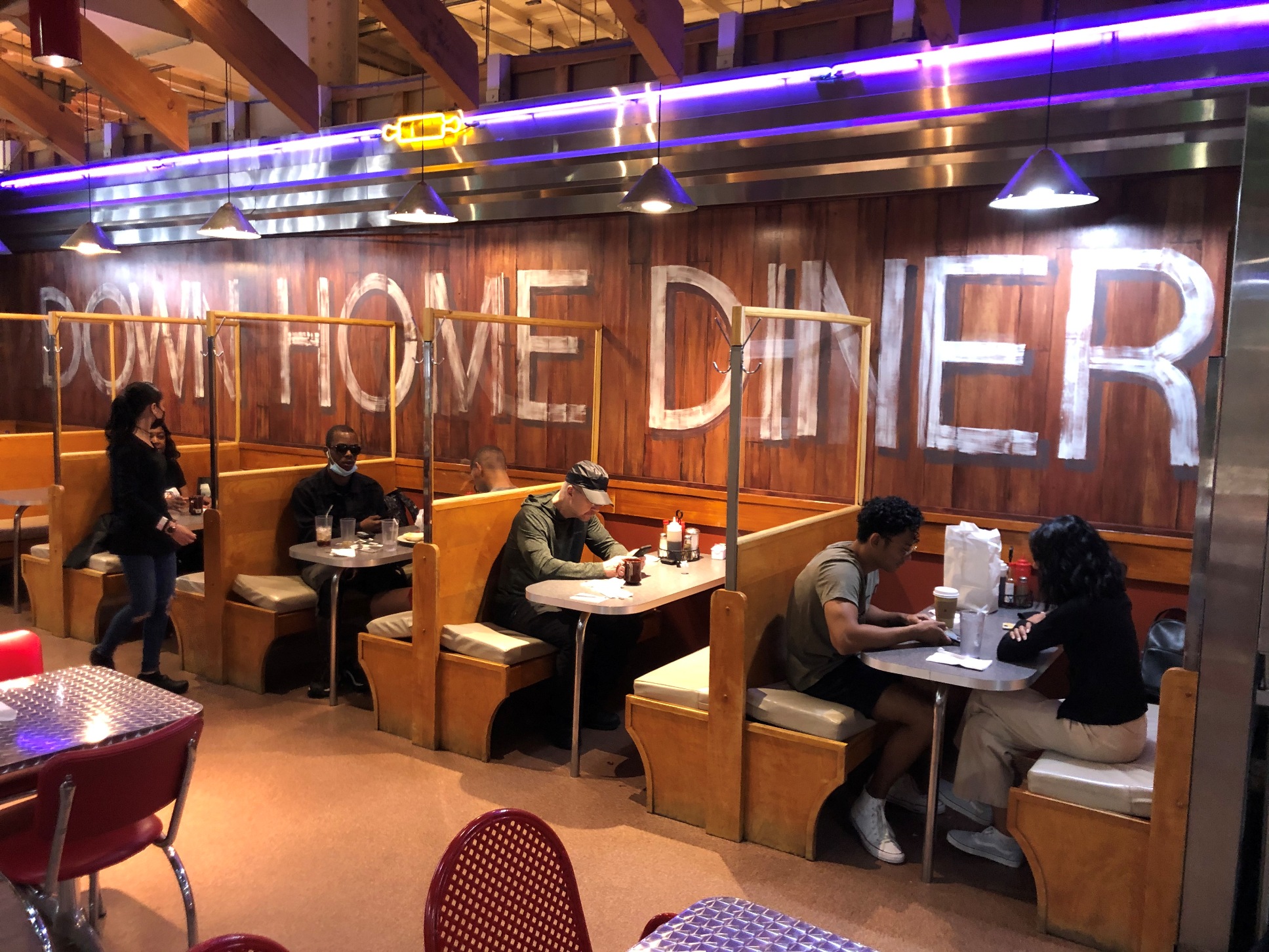
Social distancing is worth enduring for down home cooking.
“Pandemics end,” Murphy reflects, “and I think there is some light at the end of the tunnel with all the great news recently about vaccines. The best experience of the Reading Terminal Market is to come and visit us yourself. Ultimately, what we love to see here is people come through our doors to visit, because it is such a great food experience.”
That it is, even if it’s a torturous dilemma to choose from dozens of world-class eateries. Fortunately, Murphy is confident we’ll have many more opportunities to experience it all.
“There’s obviously a very clear love for the Market. That love has been built over 128 years, and our plan is to build it for 128 more.”
And Down Home Diner’s scrapple alone could keep us coming back until 2149.
Did this post make your day a little bit?
I hope so. If it did, I would really appreciate your support.
When you use this link to shop on Amazon, you’ll help subsidize this great website…at no extra charge to you.
Thanks very much…come back soon!

The Market has all you need.
(photo courtesy of Carolyn Wyman)
The Market Sampling Tour
The Taste of Philly Food Tour people can help you a tiny bit with the agonizing challenge of what to get at the Market. You can book an inexpensive tour of the Market on Taste of Philly Food Tour’s website, although as of this writing tours are still suspended.
Author Carolyn Wyman runs the site and tour, and she knows a bit about food in our fair city. She’s the author of The Great Philly Cheesesteak Book, the definitive guide to classic vendors of Philly’s signature sandwich. The very well done book even mentions 2004 presidential candidate John Kerry’s costly cheesesteak faux pas.
The tour is not actually through Philadelphia but is simply a tour of the Market itself; Carolyn or one of her friends leads visitors through the Market and shares stories of its history…along with, of course, tastings.

Miller’s pretzel cheesesteak anyone?
According to Wyman, samples that patrons get to try (based on group size and dietary issues) can include:
– A piece of a Miller’s Twist pretzel
– Scrapple from Down Home Diner or Dutch Eating Place
– Snapping turtle soup from Pearl’s Oyster Bar
– Butter cake from the Flying Monkey Bakery
– Jewish apple cake from Hershel’s deli
– Butterscotch vanilla ice cream from Bassett’s
– Wilbur Buds and Goldenberg Peanut Chews from the PA General Store.
Wyman adds, “The tour definitely includes ideas on other great foods and best finds in the Market…the most popular donut at Beiler’s, the unique Philly cream cheese cheesesteak at Carmen’s, the summer-only lemon cooler cake at Termini’s etc.”
Certainly enough to assist in that blasted decision process, and samples are small enough that you’ll still have room to order a full version of what you liked the most.
The Market’s website calls it “fun history that has nothing to do with government”. Something to consider for the next field trip with the kids.
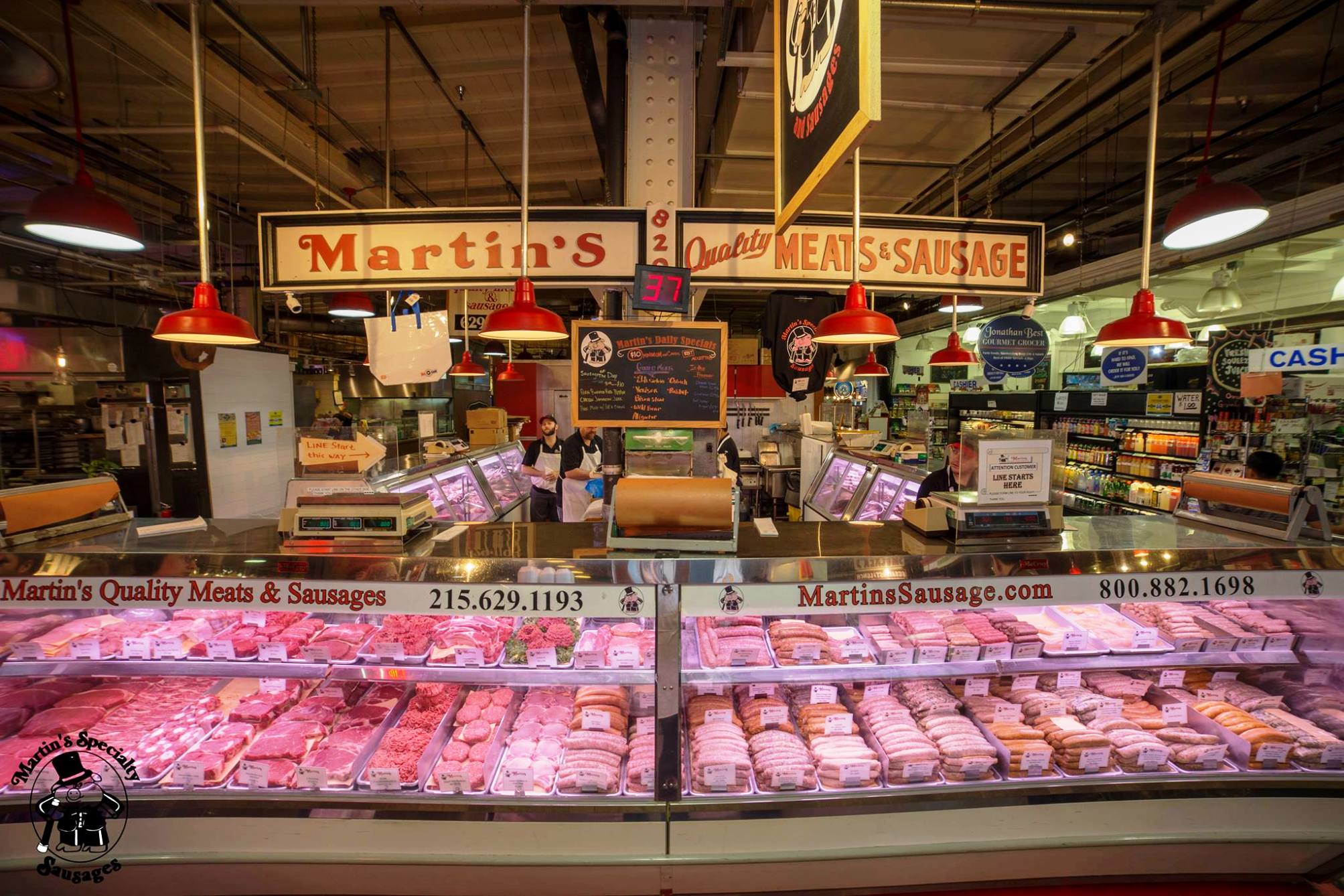
I looked behind the counter. Diane Kruger wasn’t there.
(photo courtesy of Martin’s)
A True National Treasure
The Market has made a few appearances in American cinema, most notably in the 2004 hit National Treasure.
You may remember the scene: Abigail (Diane Kruger) and Riley (Justin Bartha) temporarily escape from villain Ian Howe’s (Sean Bean) henchmen in the Market, and Abigail temporarily hides behind the counter of Martin’s Quality Meats. The woman working behind the counter, after initially informing Abigail that she doesn’t belong there if she’s not a steak, lets her stay believing that she’s running from her ex-husband.
The movie crew brought in close to 50 extras to pose as customers (the woman behind the counter was an actress named Sharon Wilkins) and spent 14 hours on two Sundays filming the scene. Gabrielle Giunta, daughter of Martin’s owner Martin Giunta, told JerseyMan about it.
“The market was closed on Sundays, and they asked us to open and set the case on a Sunday to do the filming. The producer put an actress behind the counter for ‘customer service’ and they had to film the scene a bunch to get it right.
“A lot of people did ask us about that in passing – was pretty cool as a kid to hear people ask my dad about being in National Treasure.”
The chase scene, like the rest of the movie, turned out superbly. But the movie makers seriously screwed the pooch on feeding the crew. They brought in a trailer from an outside caterer, rather than letting the crew dine on the countless offerings from the Market itself.
If you’ve never seen the movie, you can view the scene on YouTube. (But check out the whole movie…it’s good.)
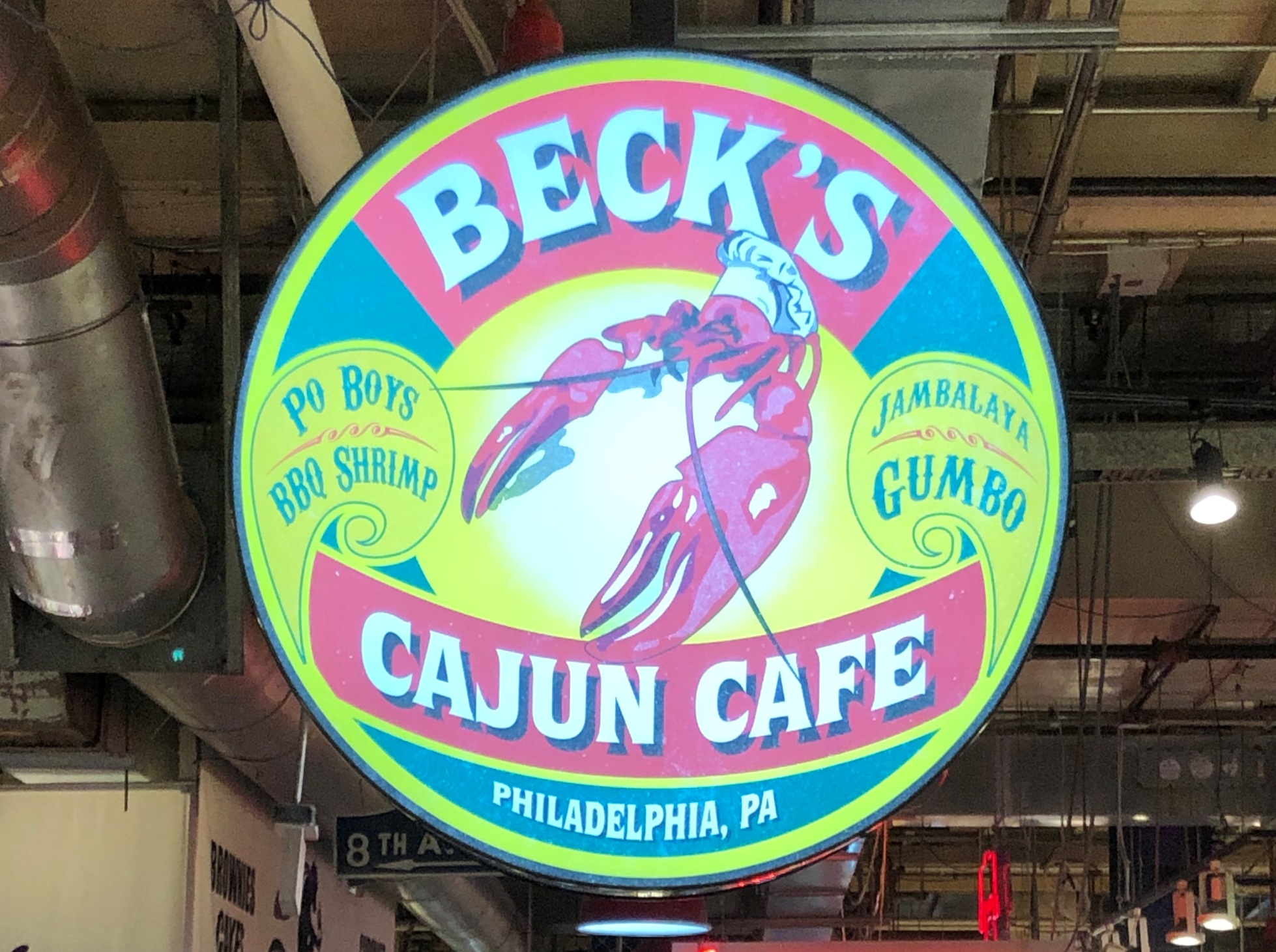
Now delivering to your area!
Bringing The Market To You
As Conor Murphy points out, the Market has partnered with Mercato, the online grocery delivery service. Thanks in part to the pandemic, you can now order food from most any Reading Terminal Market merchant, and have it delivered within a reasonable radius.
Be warned; the process of choosing isn’t any easier…but at least you can take some time to think about it. The merchants’ logos are featured in a rotating slider, enabling you to choose one and view their delivery offerings. Order a blackened chicken platter from Beck’s Cajun Café, a vegetable lasagna from By George, and a pound of smoked wings from Dienner’s. Add three chocolate swirl banana puddings from Sweet Nina’s for dessert, and you’ve got a few days’ worth of fantastic food in the comfort of your own digs.
It’s not cheap; the shopping excursion just described will set you back just over $75 if you’re sending it to Turnersville. But it spares you the gas, tolls, parking, and travel time, and Mercato will bring the fabulous flavors of the Market to your front door. Mercato offers discounted delivery when you join their Green service.
It’s a great way to experience the Market without leaving your home, which, as we’ve all recently learned, is something that could afflict anyone.
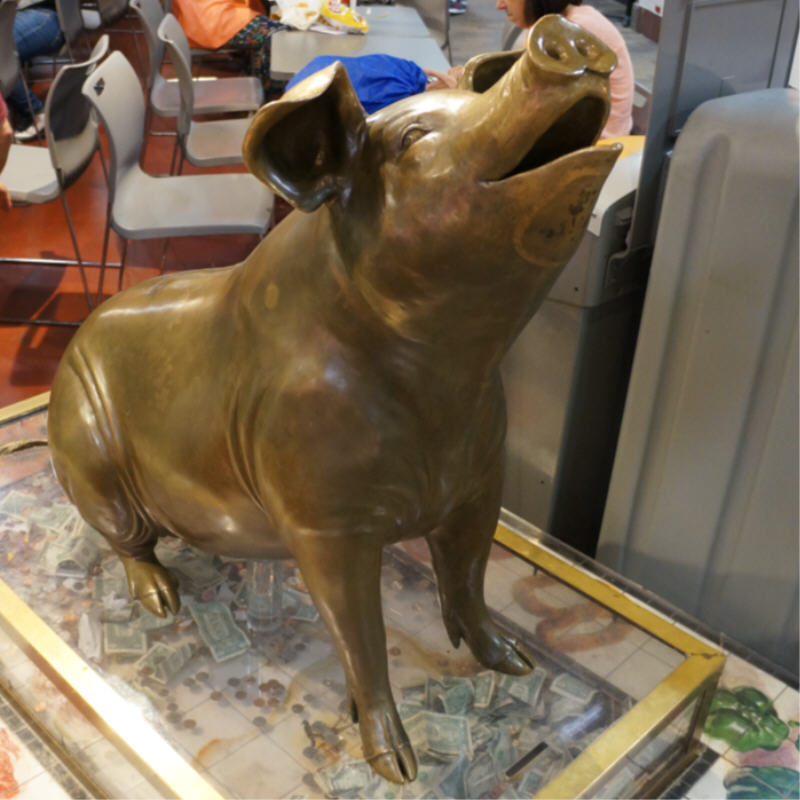
The ever-pleasant Philbert, collecting money for the hungry in Philly’s favorite food market.
(photo courtesy of London Faust)
Philbert, The Reading Terminal Market Mascot
If you’ve visited the Market, you may or may not have noticed Philbert, the life-sized pig statue that sits on a box of coins in the center of the market. Philbert is named for Filbert Street, one of the streets adjoining the Market.
Philbert was sculpted by Eric Berg, who passed away of heart disease in May of 2020, at the age of 74. Other Berg structures in the city include the Drexel dragon, the panda at the Children’s Hospital, and the African Warthog at the Philadelphia Zoo. You can view his impressive body of work here.
In addition to being a popular Market meeting spot, Philbert is in fact a piggy bank; visitors can drop coins in its mouth, which eventually lands in the glass box on which Philbert sits. The money in the box is then donated to a different charitable organization each month, as determined by the Philly Food Trust.
You can rub his snout for good luck too, as many do; maybe it will help you make that all-important food choice at the market.
Source: Atlas Obscura

Crowdfunding – The Kindness of Strangers

Crowdfunding sites like GoFundMe, Kickstarter and Indiegogo make a substantial profit helping ordinary Joes raise money for causes. JerseyMan asked me to cover them for the December 2016 issue; you can view the PDF of the article here.

Crowdfunding – The Kindness of Strangers
Crowdfunding sites like GoFundMe, Kickstarter, and Indiegogo have helped thousands of causes…and it’s turned out to be an extremely lucrative business model.
Not very long ago, arranging a benefit involved considerable footwork.
You organized a golf tournament or pancake breakfast to raise money for the ailing and downtrodden. Or sold candy bars to pay for your kid’s Little League uniforms. Or peddled raffle tickets that people bought with internal groans, knowing they weren’t going to win the cruise.
It was difficult enough fundraising for people with genuine, maybe even life-threatening needs. Everyone wants to help the sick child. Try inviting folks to an overpriced spaghetti dinner to subsidize your drifter nephew’s musical career.
Today, if you have enough Facebook friends, you can raise money to help a blind man keep a retiring seeing eye dog, lessen the medical bills of Boston Marathon bombing victims, or finance the first new season of Mystery Science Theater 3000 in almost 20 years. All without leaving your doorstep.
It’s called “crowdfunding”, and it’s booming.

Helping you “donat” to a good cause.
Out of dozens of crowdfunding sites, GoFundMe is arguably the biggest household name…it was valued at around $600 million when the founders sold it in June of 2015.
Like most such outfits, GoFundMe collects a portion of each donation, usually 5%, as the fee for its services, plus a payment processing fee of about 3%. For the $7.8 million (and counting) raised for victims of the Orlando nightclub shooting alone, GoFundMe took in a cool $624,000 in fees for one campaign.
GoFundMe is not a philanthropic entity. Nor does it pretend to be. It is a profit-driven company; the majority of donations are not tax-deductible.
If users and donors have a problem with this, most of them haven’t said so. Probably because it works: the profit motive benefits the philanthropists. It’s in GoFundMe’s interest to increase donation amounts. That they do very well.
GoFundMe has an easy-to-use interface to create a page and tell one’s story, the ability to easily share it on social media, and a secure donor payment system. They offer a primer with fact-based advice, like how sharing a campaign on Facebook increases donations by 350%. If your tale is particularly touching, GoFundMe will feature it on the front page, to be viewed by thousands of altruistic-feeling types.
GoFundMe is phenomenally successful because of the stories themselves…like making a home accessible for an Annapolis woman who defeated Hodgkin’s twice, only to become paralyzed by treatments. Or finding a residence for the homeless Boston man who discovered a bag containing $42,000 and returned it to its owner. Or enabling an 89-year-old Chicago gentleman to finally retire from selling popsicles on the streets. Anytime you think the world is full of selfishness and greed, visit GoFundMe and see countless stories of tragedy, inspiration, and astounding human generosity.
However fabulously wealthy that makes the owners of GoFundMe, 8% of donations going to expenses is better than most philanthropic organizations manage. According to Charity Watch, American Red Cross uses 10% of donations for overhead, while the ACLU sets aside a full 24%…which is still good enough for an A- rating. Few well-known charities operate at less than 8%.
GoFundMe’s focus is generally helping the less fortunate, but if you are looking to finance your new invention or book project, Kickstarter is more up your alley.

A deadline is a great motivator.
Aspiring entrepreneurs approaching venture capitalists may make for entertaining television, but there’s a reason ABC’s hit show is called “Shark Tank”.
In the show, naïve hopefuls strut into a room of wealthy businessmen to menacing music, as if they have no inkling of the psychological carnage in store for them. Mere minutes after executing an entertaining introduction of their product, resourceful inventors flail helplessly as the Sharks pounce on their weaknesses and one by one bow out of supporting their lifelong dream.
Imagine bypassing hat in hand encounters with tycoons whose only interest is becoming wealthier, and going directly to the masses to evaluate the market instead…which would probably show you whether a product will sell better than even the owner of QVC could.
Thanks to Kickstarter, it’s now just as easy to ask 1,000 people to contribute $25 to your project as it is to ask one person to contribute $25,000. All you need to reach that niche market is a description of your ultra-cool product with a few videos, and maybe some sweet perks for larger donors. Set a goal; if you reach it, the demand is probably there. What could be more free market capitalism?
Kickstarter shows that there can be an audience for almost anything one enjoys creating, no matter how off the reservation it may seem. One current project is an album of jazz interpretations of Nintendo NES video game themes. Before you ask what kind of nostalgic screwball pines for a jazz version of Legend of Zelda music, you should know that that campaign has raised $7,725 as of this writing, and is under $1,000 away from being fully funded. Yes, someone wants that.
Enabling dreams helps Kickstarter do pretty well with their bottom line too. At any moment, a visitor can view how much money has been committed to projects and how many projects have been successfully funded in the company’s history. As this sentence was written, those numbers are $2,707,572,645 and 114,642, respectively. Not bad for a company that employs just 115 people.
While GoFundMe allows users to keep all of the donations received whether a goal is reached or not, Kickstarter requires users to reach their stated goal or collect nothing. Kickstarter stresses that this is a good thing…it attaches motivation to get to the finish line when one is facing a fruitless campaign otherwise. And as a Kickstarter rep explains, “not reaching your goal can be very useful information.”
Kickstarter also deliberately avoids the type of charitable fundraisers that appear on GoFundMe…a potential donor could be conflicted seeing a disaster relief campaign next to a film idea they like. Indiegogo, which bills itself as “the largest global crowdfunding and fundraising site online”, doesn’t seem to mind this.

And then someone said, “What if the actual road itself was made with solar panels?”
Does GoFundMe’s keeping a twentieth of what you raised for the cancer patient trouble you? If your cause is a charitable one, Generosity by Indiegogo collects only payment processing fees and charges no other fees. Your only challenge to keep that 5% is convincing your Facebook audience that Indiegogo is as reputable as GoFundMe, which isn’t difficult.
Otherwise, Indiegogo’s focus is entrepreneurial ideas. But unlike Kickstarter, Indiegogo isn’t “all or nothing”; should a goal be reached, users collect all of it minus a 4% fee, as opposed to 5% on Kickstarter. Users can also cut their losses…should the goal not be reached, they can keep what they have raised, this time for a 9% fee. The pressure is still there, but it isn’t as great…and might not be as motivational.
That doesn’t stop people from using Indiegogo, partly because of other advantages the company offers. Indiegogo, for example, allows a campaign to continue raising money after its end date. According to John Vaskis, Indiegogo’s head of Hardware, Technology and Design Outreach, “Entrepreneurs can raise more money on Indiegogo than anywhere else, because we are the only platform that provides pre-sales and retail options even after their crowdfunding campaigns end.”
One great example of this is Solar Roadways – yes, roads made from solar panels that melt snow and are lit with LEDs. Even in the face of some scientifically-based skepticism, Solar Roadways has raised over $2.2 million, and is now an ongoing “InDemand” Indiegogo campaign.
Should that one work out nationally, it would probably be worth Indiegogo’s four percent cut.

Sure, a 5K is great for exercise. But there are easier ways to raise money.
Crowdfunding eliminates a great deal of fundraising stress…not just by avoiding face-to-face rejection from humans with a lifetime of practice saying no, but also eliminating the fatigue from repeating a troubling story or elevator pitch.
When Tina Ottaviano of Mantua Township learned that her son Braison was diagnosed with a brain tumor (which has since, thankfully, stabilized – Braison is doing quite well), she set up a webpage through CaringBridge.org to tell his story and raise money for treatments. CaringBridge is not a crowdfunding site per se, but they do link journals to GoFundMe pages if users desire.
“As much as I appreciated people asking me about Braison,” she says, “it was draining on me. Sometimes I just didn’t want to talk about it.”
With CaringBridge, Ottaviano could “just give people the link, which would send email notifications when I made an update. Then people would tell other people, etc. I set up an external fund account to help raise money with all the costs.
“It was very successful.”
It takes a special kind of personality trait to coax hard-earned money from people, even for an undeniably worthy cause, that many of us lack. We’re too proud to ask without offering a chance to win a ski resort vacation in return. We’re all aware how irritating telemarketers are.
Sites like GoFundMe, Kickstarter and Indiegogo almost effortlessly target the audience for raising needed dough, and they enable a campaigner to agonize over the story just once.
Their balance sheets reflect a spectacularly grateful world.
Did this read about crowdfunding make your day a little bit?
I hope so. If it did, I would really appreciate your support.
When you use this link to shop on Amazon, you’ll help subsidize this great website…at no extra charge to you.
Thanks very much…come back soon!

Turn a profit or help the planet? Both.
The “Benefit Corporation” And Crowdfunding
Remember when President George W. Bush ran as the “compassionate conservative”? The term implied that conservative = heartless. It was Dubya’s outreach to that “middle ground” voter. It might have been disingenuous or paradoxical, but the compassionate conservative did win two terms as president.
Similarly, the term “corporation” doesn’t have a great connotation these days; the words “corporate America” are usually enough to create those visions…a heartless board of directors caring only about stock prices and paying CEOs multi-million dollar bonuses after laying off hundreds of employees.
Kickstarter recently submitted the paperwork to become a “Benefit Corporation”, a seemingly paradoxical appellation that actually has some literal meaning. A Benefit Corporation is a real type of business, not just a feel-good phrase to direct attention away from the size of the profits. A Benefit Corporation must not only abide by laws of corporations, but must also follow standards based on the common good.
According to Wikipedia, a Benefit Corporation must consider the impact of its decisions not just for the stockholders but also the society and the environment. How that is determined varies by state but is usually judged by an independent third party.
As Kickstarter notes on its website: “Benefit Corporations are for-profit companies that are obligated to consider the impact of their decisions on society, not only shareholders. Radically, positive impact on society becomes part of a Benefit Corporation’s legally defined goals.”
GoFundMe and Indiegogo haven’t made the jump yet to following a stricter standard for the public good. But the move of states to create additional statutes is increasing.

The Fizzics Waytap is everything that’s great about America.
(photo courtesy of Fizzics Waytap)
A Glimpse Into The Future
With all of the advances in technology in the last 20 years, imagine what life will be like 20 years from now. Indiegogo can give you at least a potential idea with some of the ongoing projects featured in their tech section:
Moka 360 – The Moka 360 is the “world’s smallest 360 camera”. It is a camera that looks to be about two inches square, and it can take a full 360 video of its surroundings at the touch of a button. It has a magnet and can be mounted onto any metal surface, and can stream live video to your tablet. Private detectives will love this one. Current amount raised: $88,668.
Fizzics Waytap – This one’s already available…John Vaskis at Indiegogo mentioned it to me: “I own one and love it”, he says. It’s a device that takes bottled or can beer and uses sound waves (!) to create “from the tap” style beer, with a nice foamy head and much denser bubbles. The company says that the foam “creates a seal for the body of the beer, locking in the carbonation so the flavor stays fresh from the first sip to the last.” Current amount raised: $1,180,444.
Acton Blink eBoard – Remember the hoverboards from Back To The Future II? That might not be very far away. The Acton Blink is an electric skateboard…it can go 22 miles per charge and has 4-wheel drive for hill climbing power. The Blink is actually designed for commuters…it’s got bright wheels to enable you to “stand out in style”. Ever go 23 MPH on a skateboard? The Acton can do it. Current amount raised: $409,031.
Travelmate Robot Suitcase – Wouldn’t you love to use the Force to move your luggage through the airport instead of dragging it? The Travelmate suitcase can cruise along and follow you wherever you go. It can move at a clip of 6.75 MPH, which is probably faster than most people can walk, and it’s smart enough to avoid tripping people in the airport. The best part? You can put another bag on top of it. Current amount raised: $8,361.
Silent Partner – You knew this one would top a million bucks raised. It’s a smartpatch that quiets snoring by creating a “quiet zone” around the snorer: it senses the snoring sound and creates a counter sound to cancel the snore sound. There is a physics name for that phenomenon – destructive interference. The company calls it “subwavelength active noise cancellation”. Current amount raised: $1,424,086.
There’s a whole plethora of cool products like this…you can check them out in the “Tech” section of Indiegogo’s website.
Photo credit: Forsaken Fotos on Best Running / CC BY
Photo credit: Cinetics on Best Running / CC BY
Photo credit: juhansonin on Best Running / CC BY
Photo credit: TravelBakerCounty on Best Running / CC BY-ND
Crowdfunding dollar sign photo courtesy of JerseyMan Magazine.
Fizzics Waytap photo courtesy of Fizzics Waytap.

